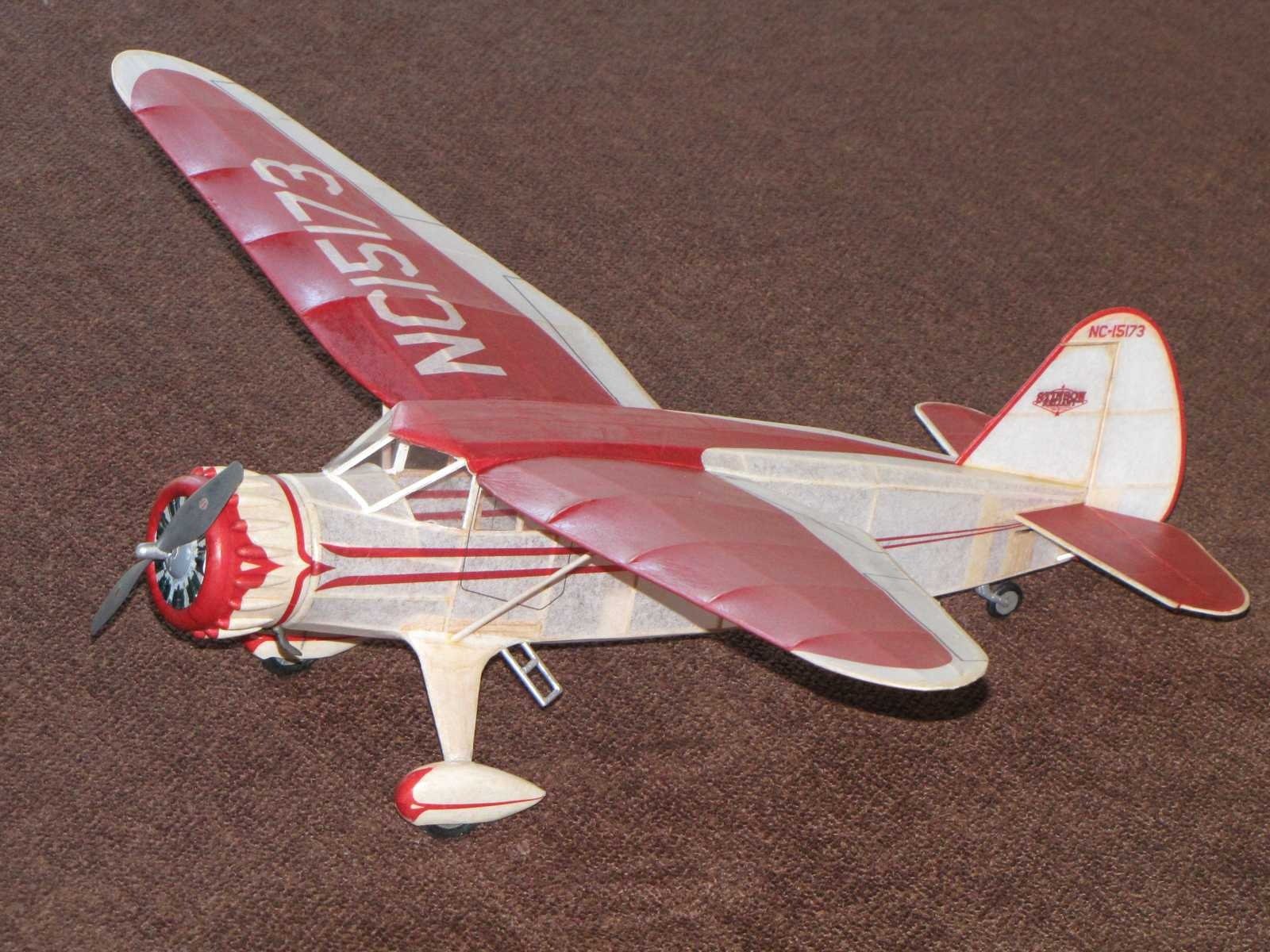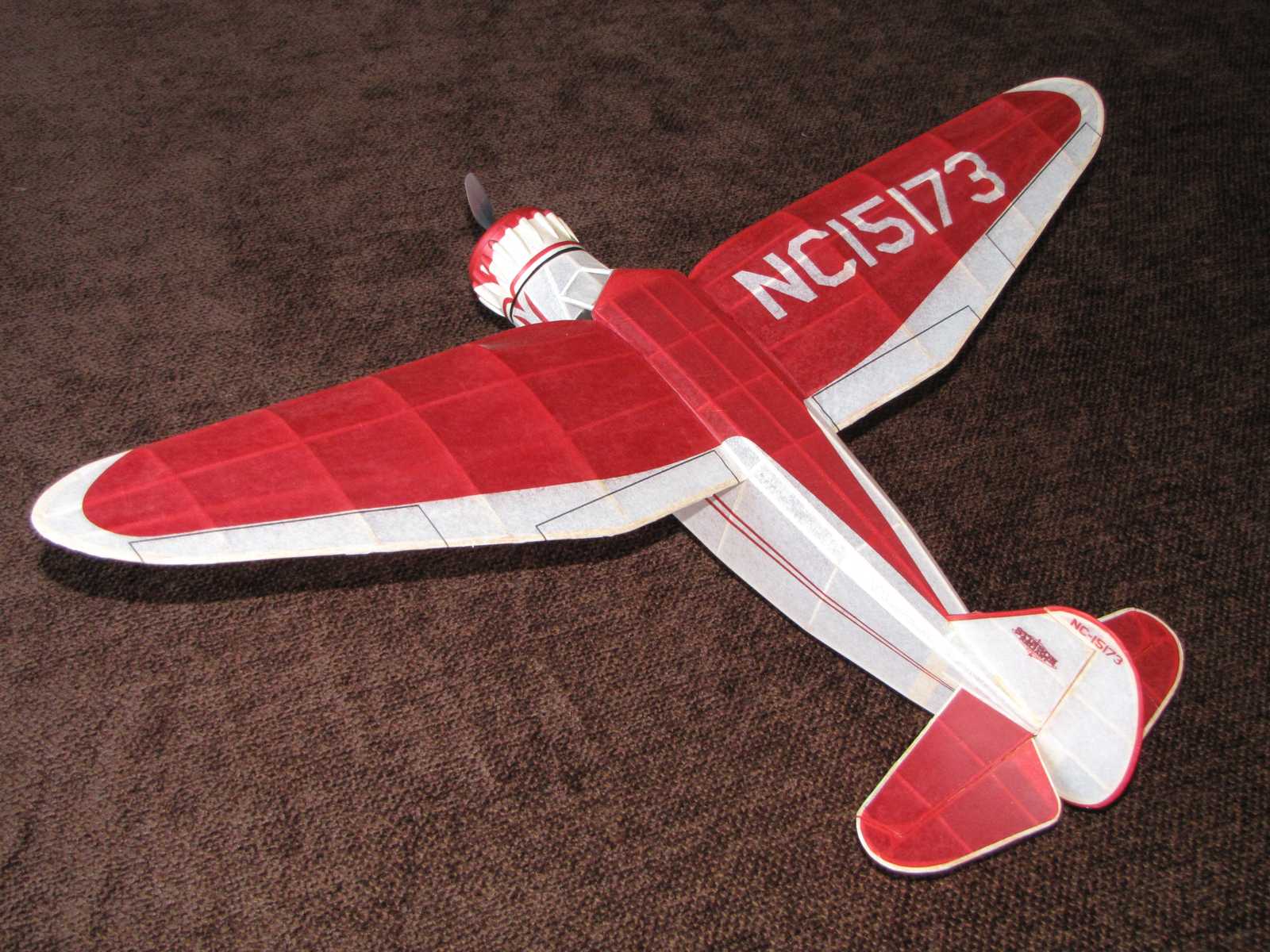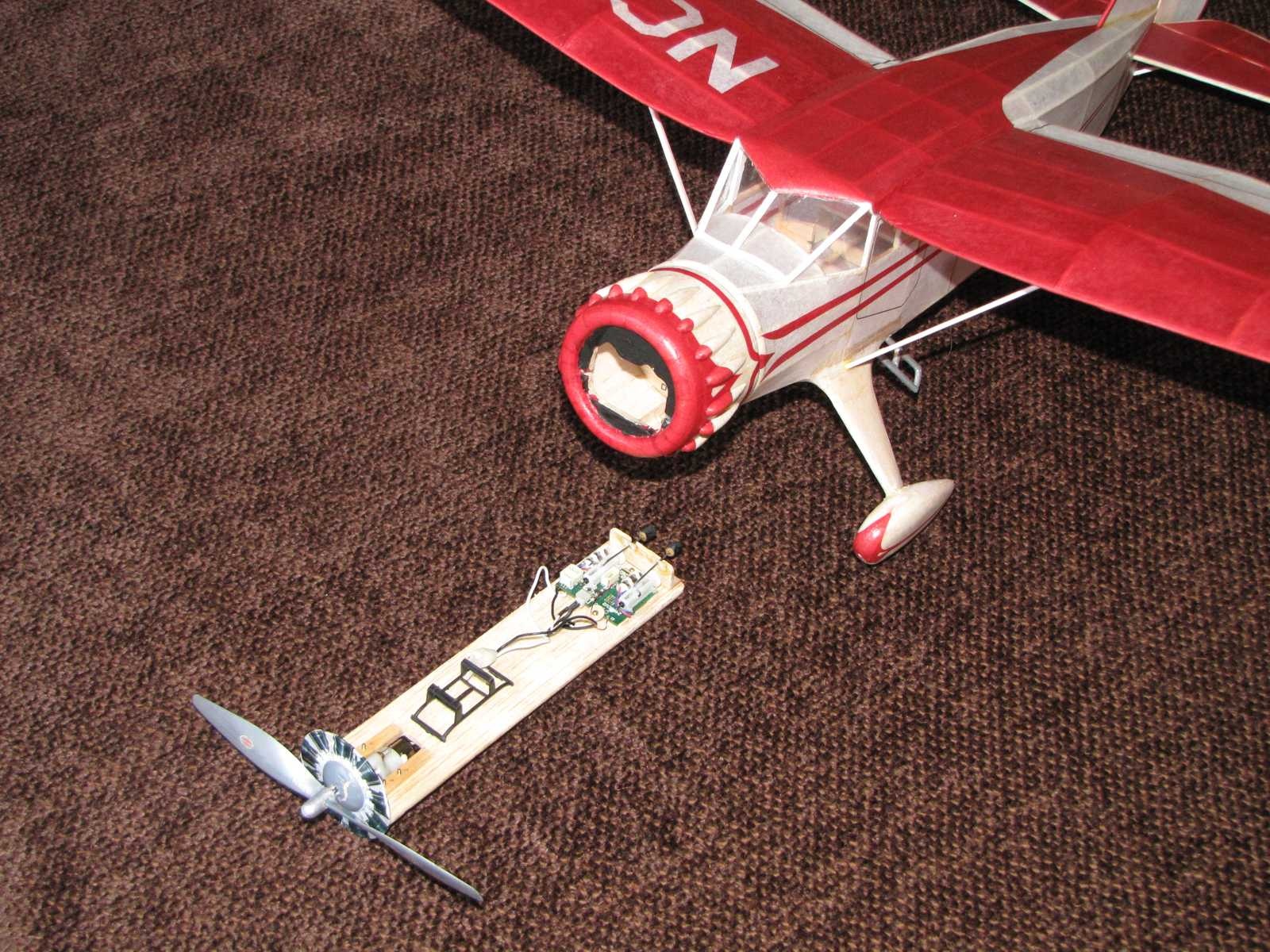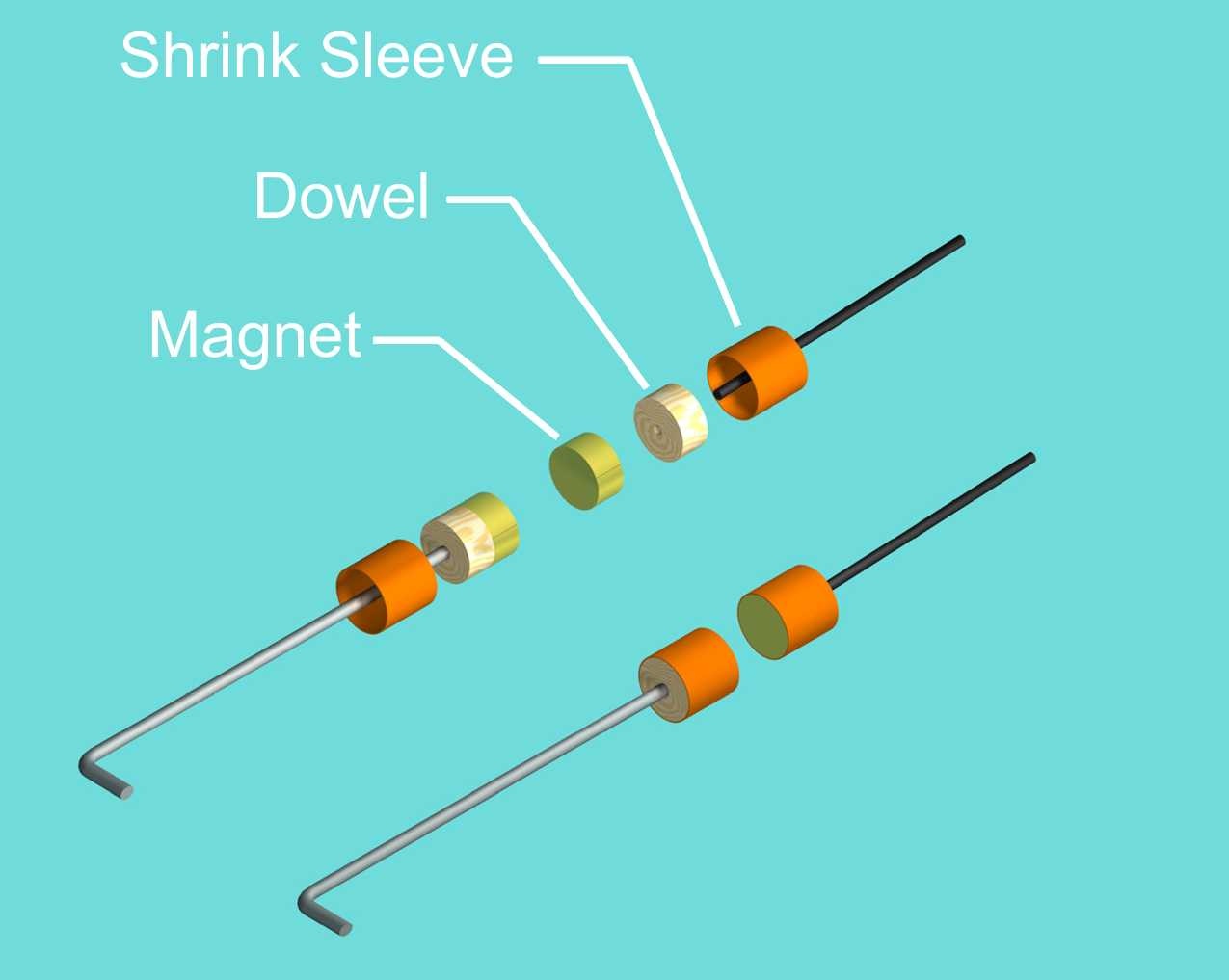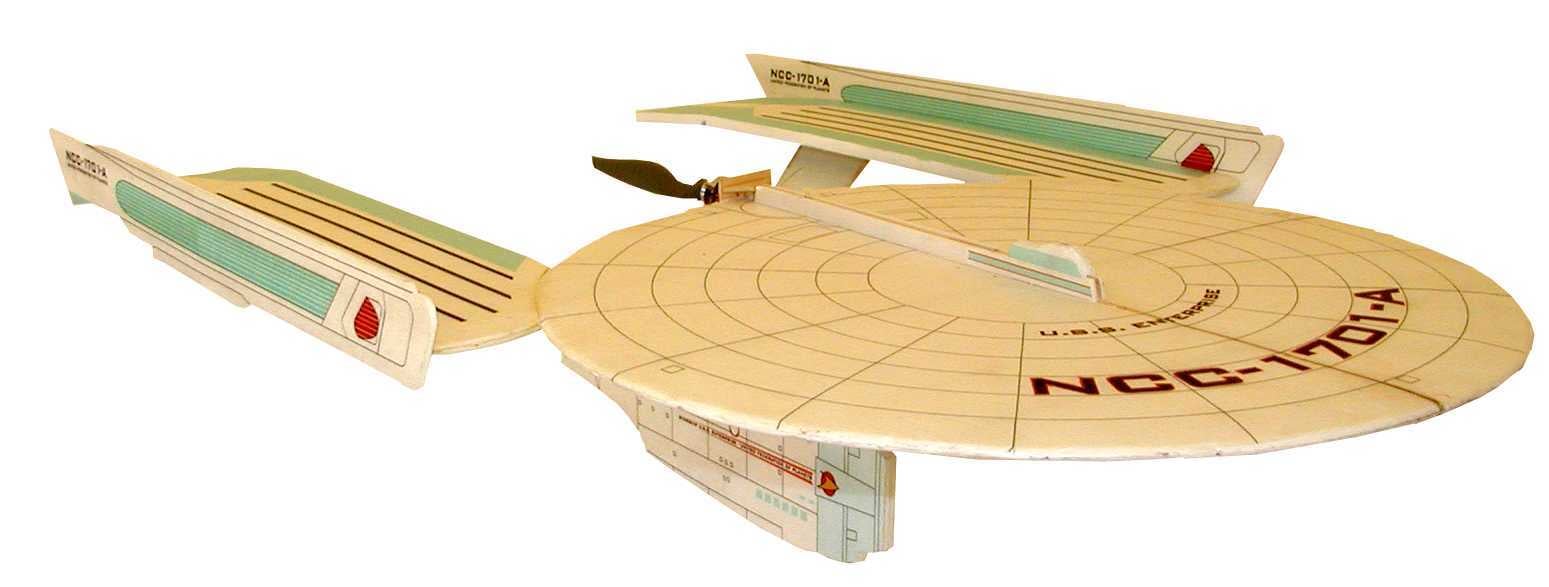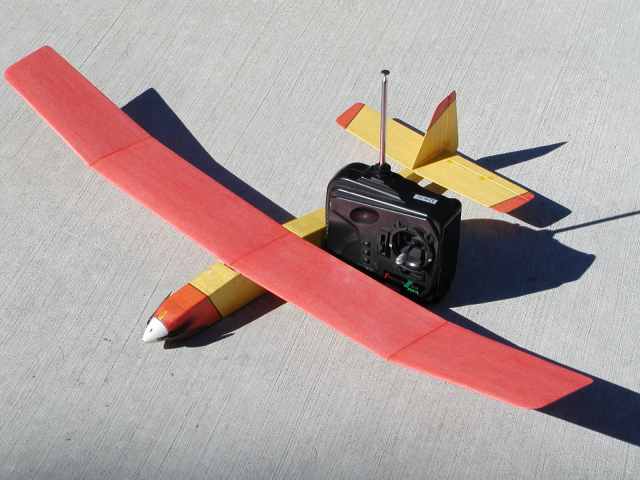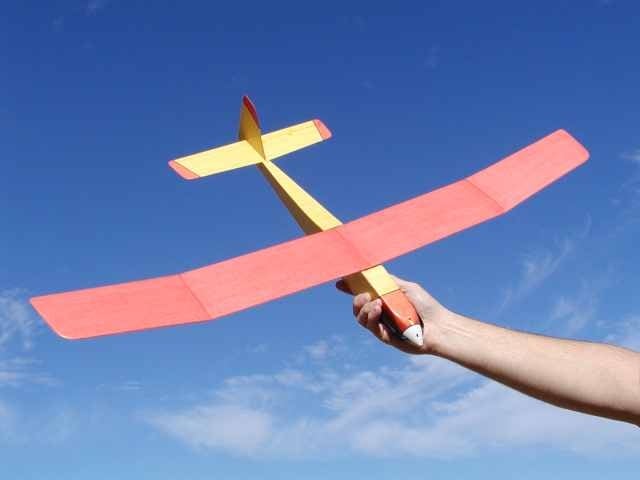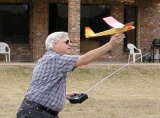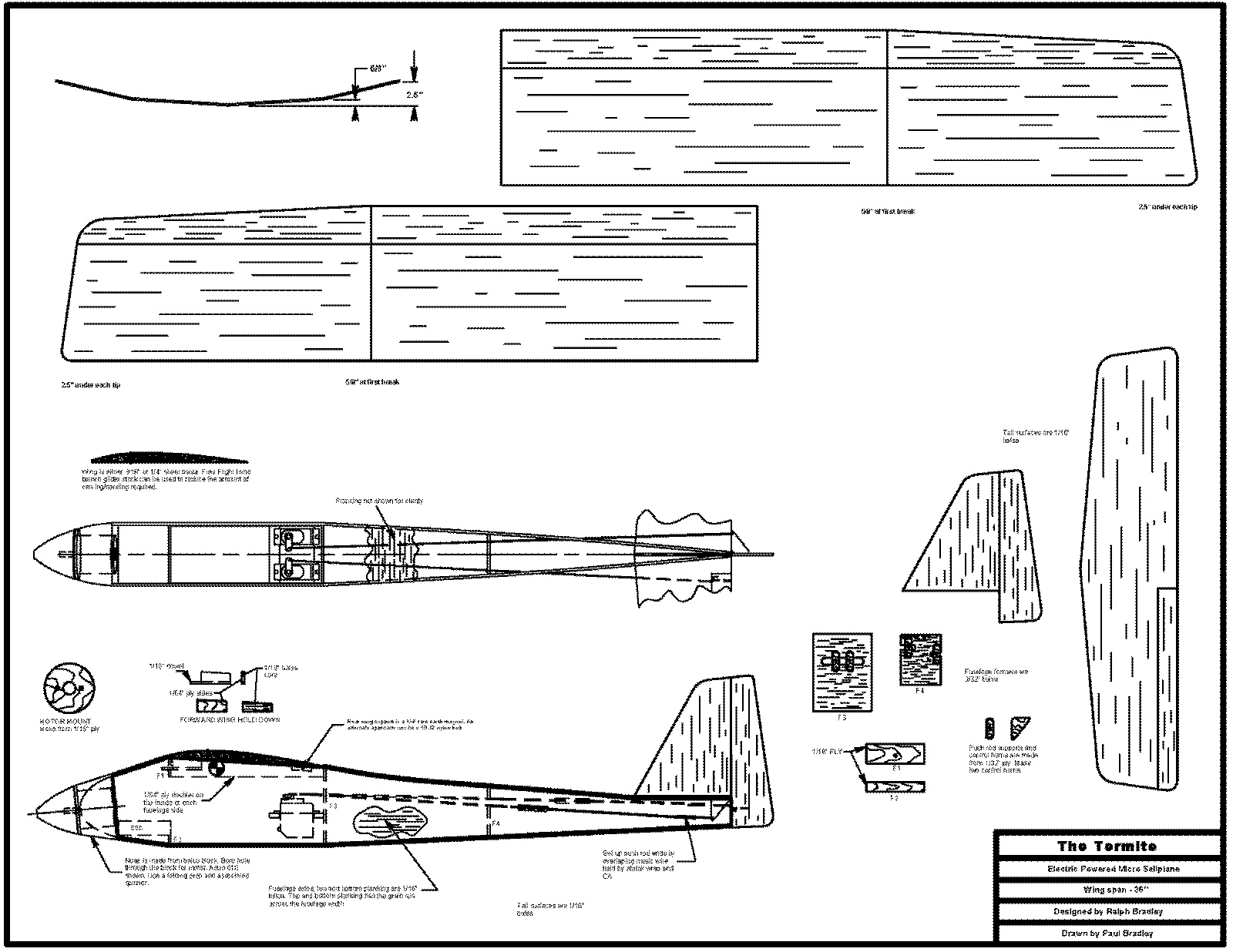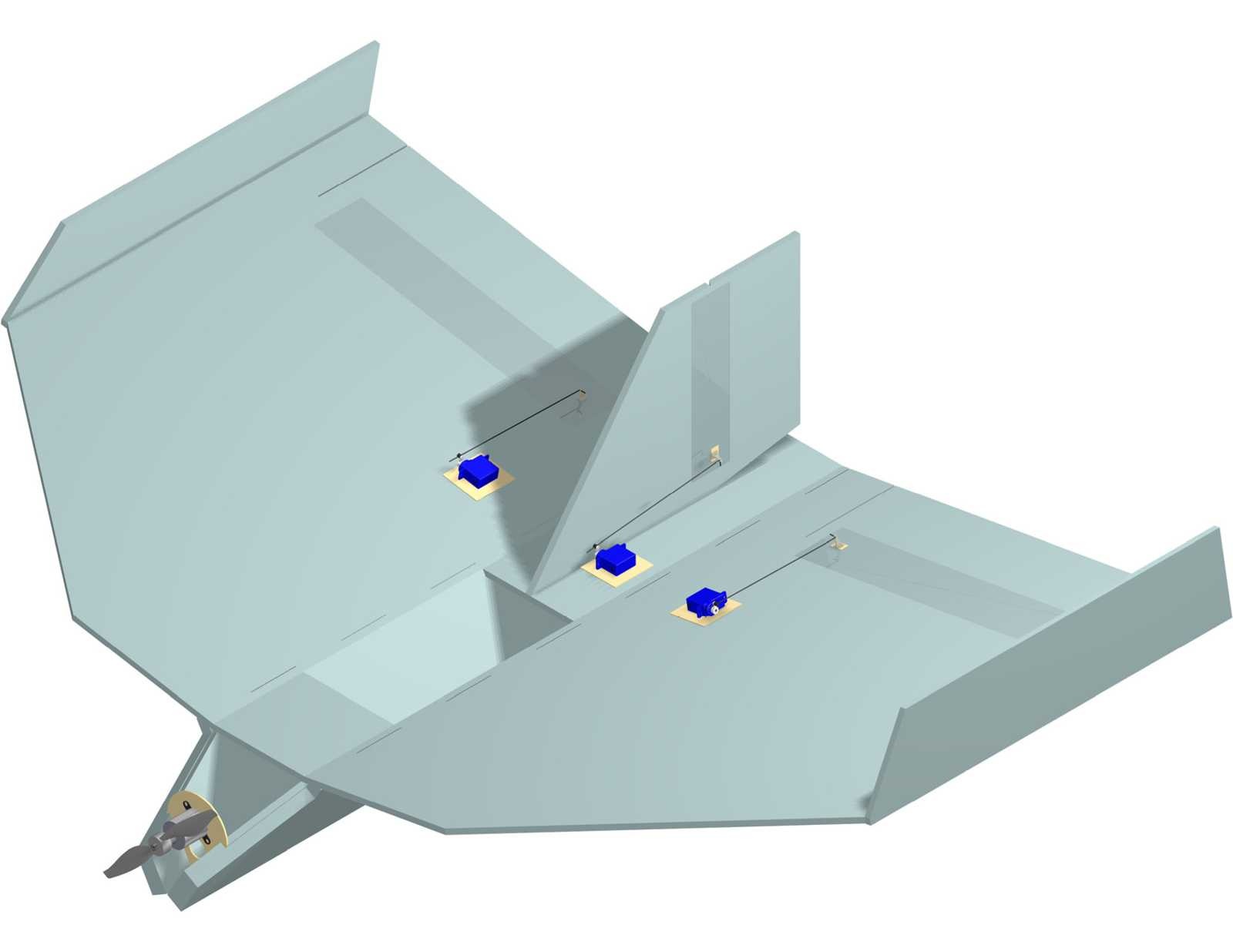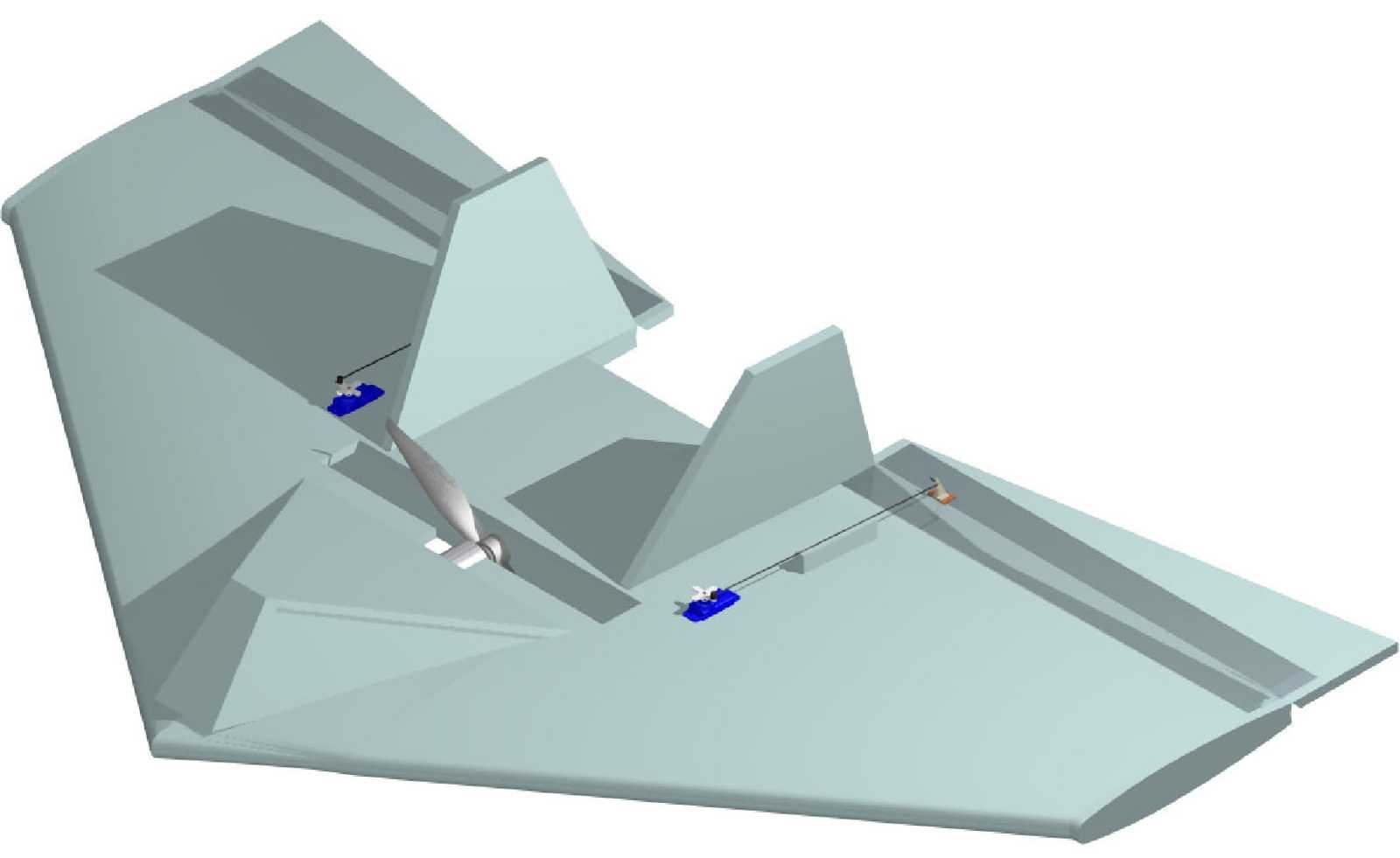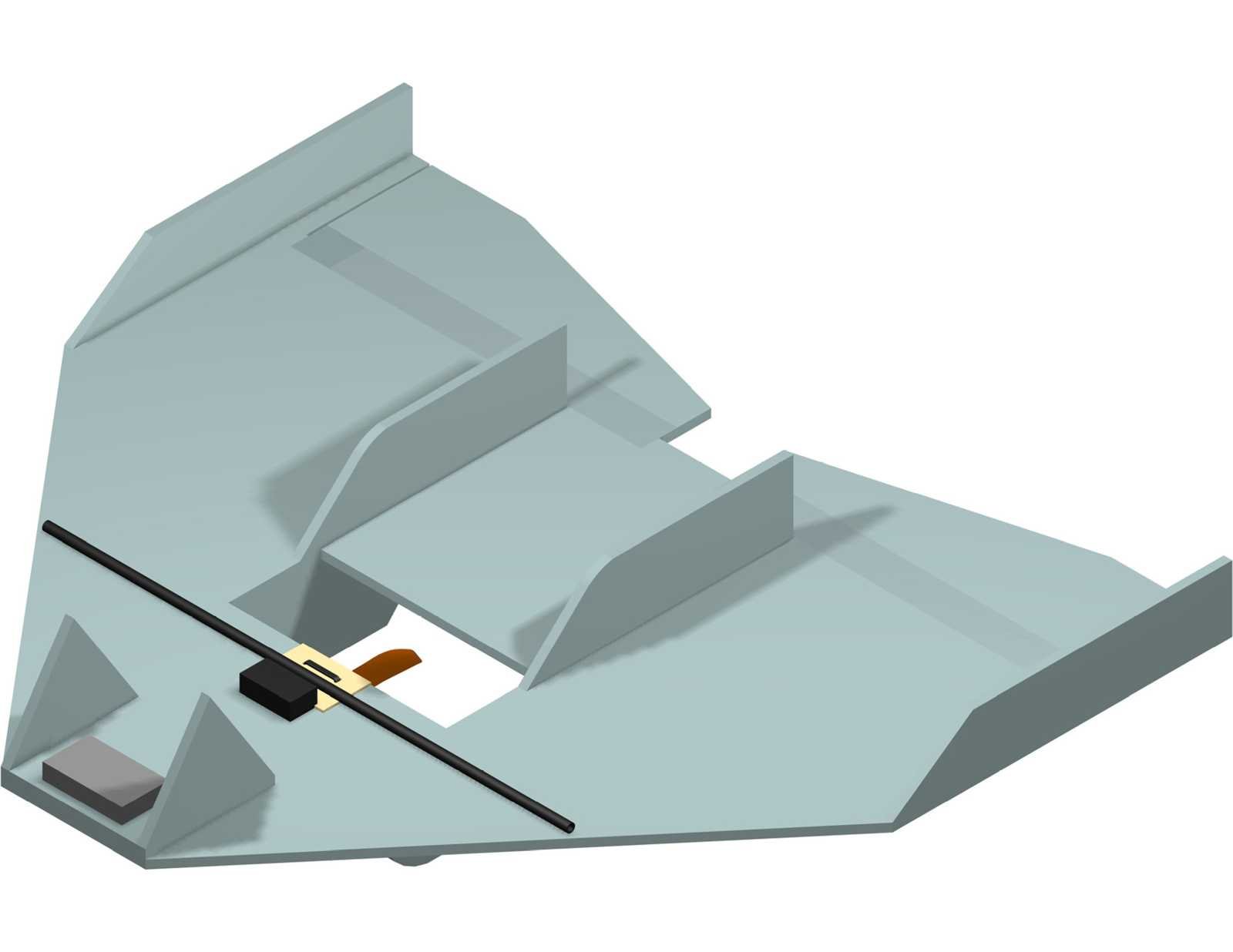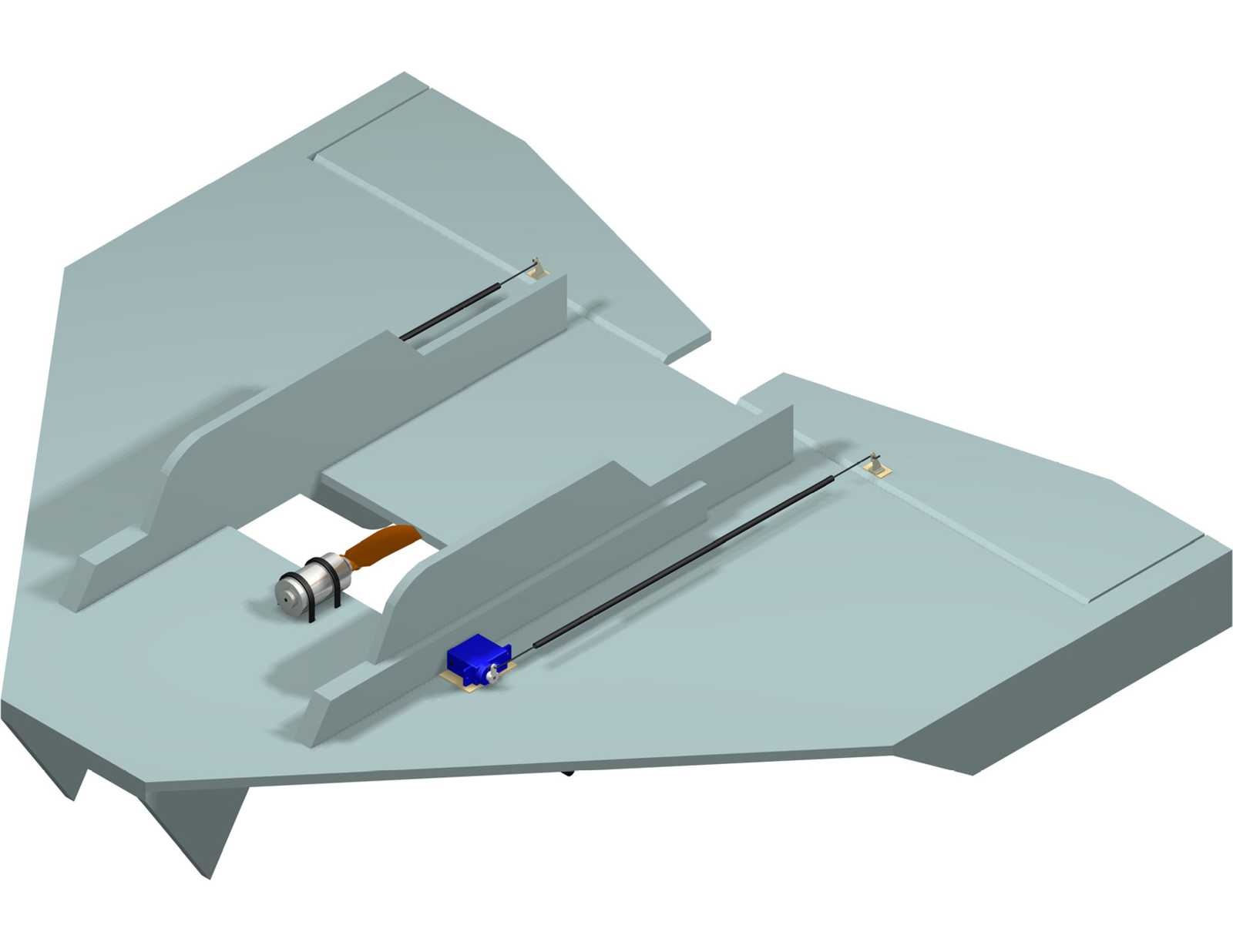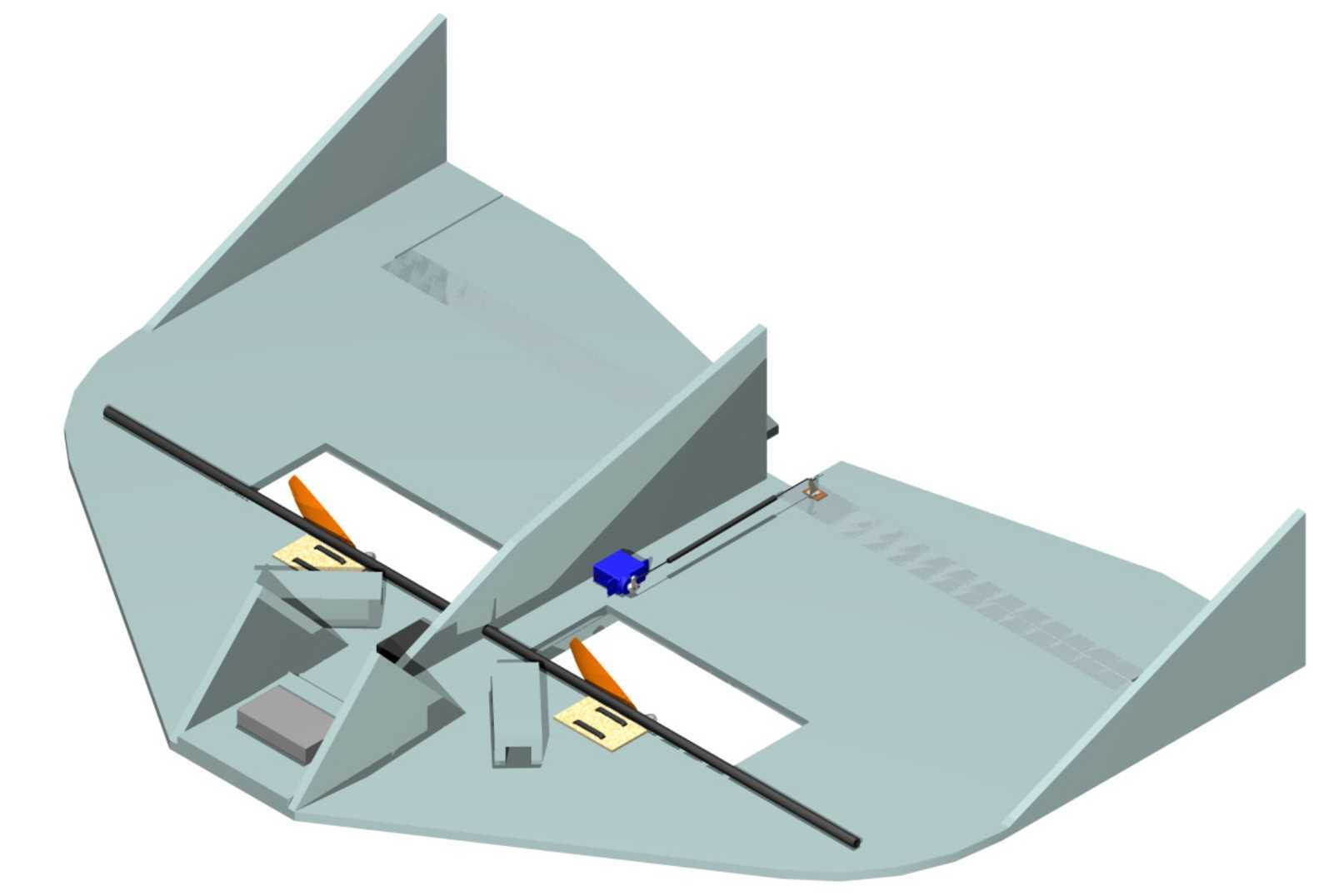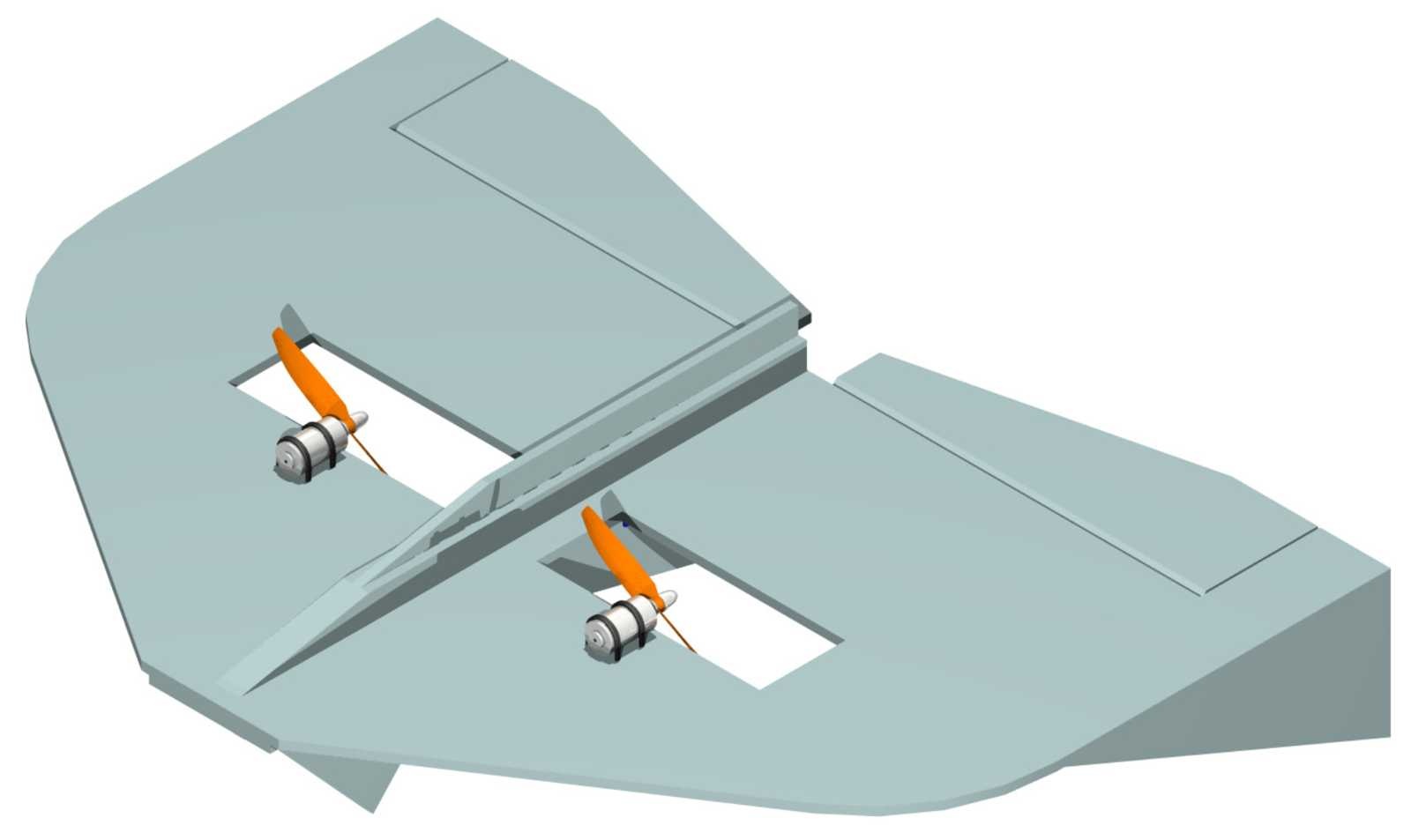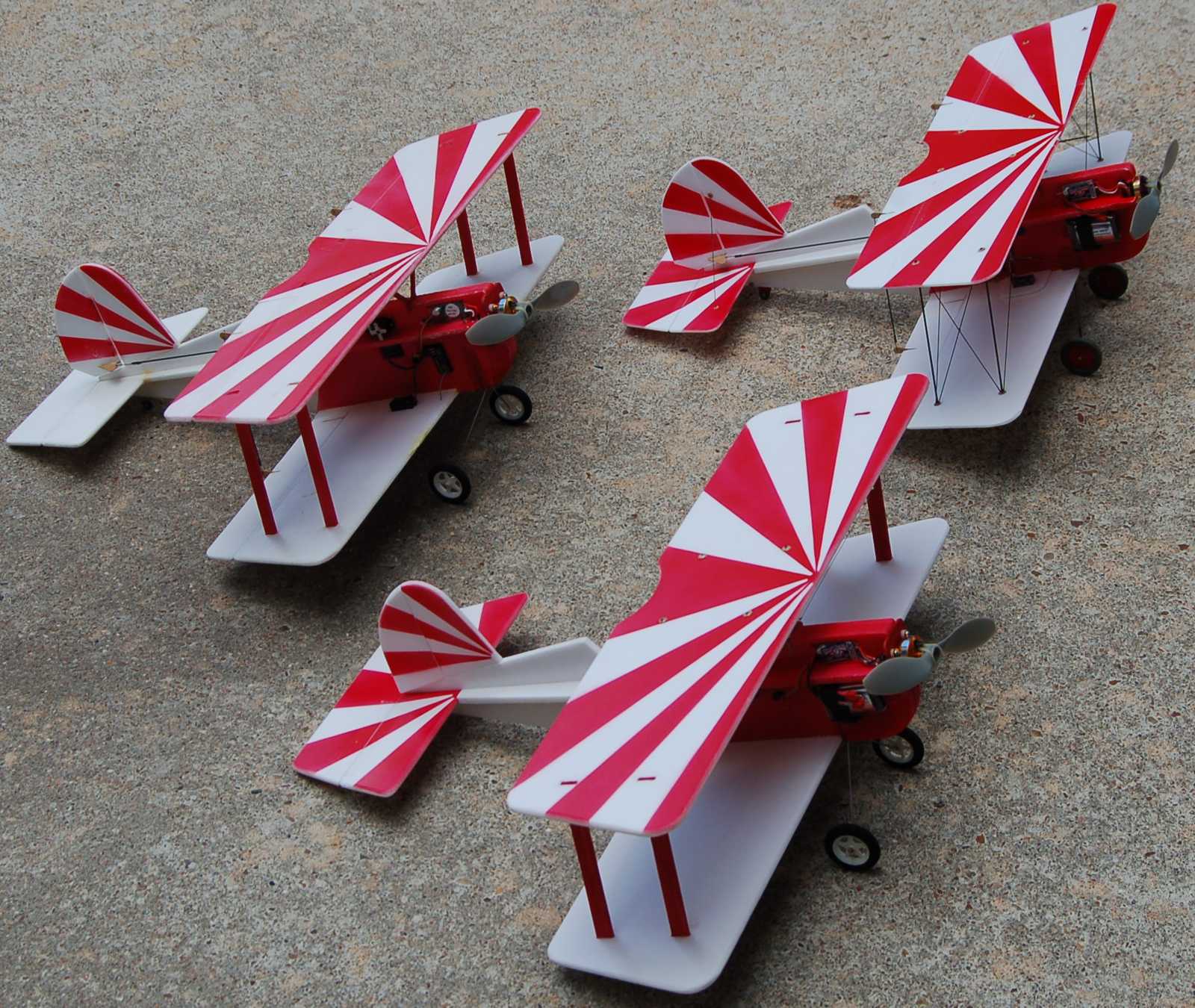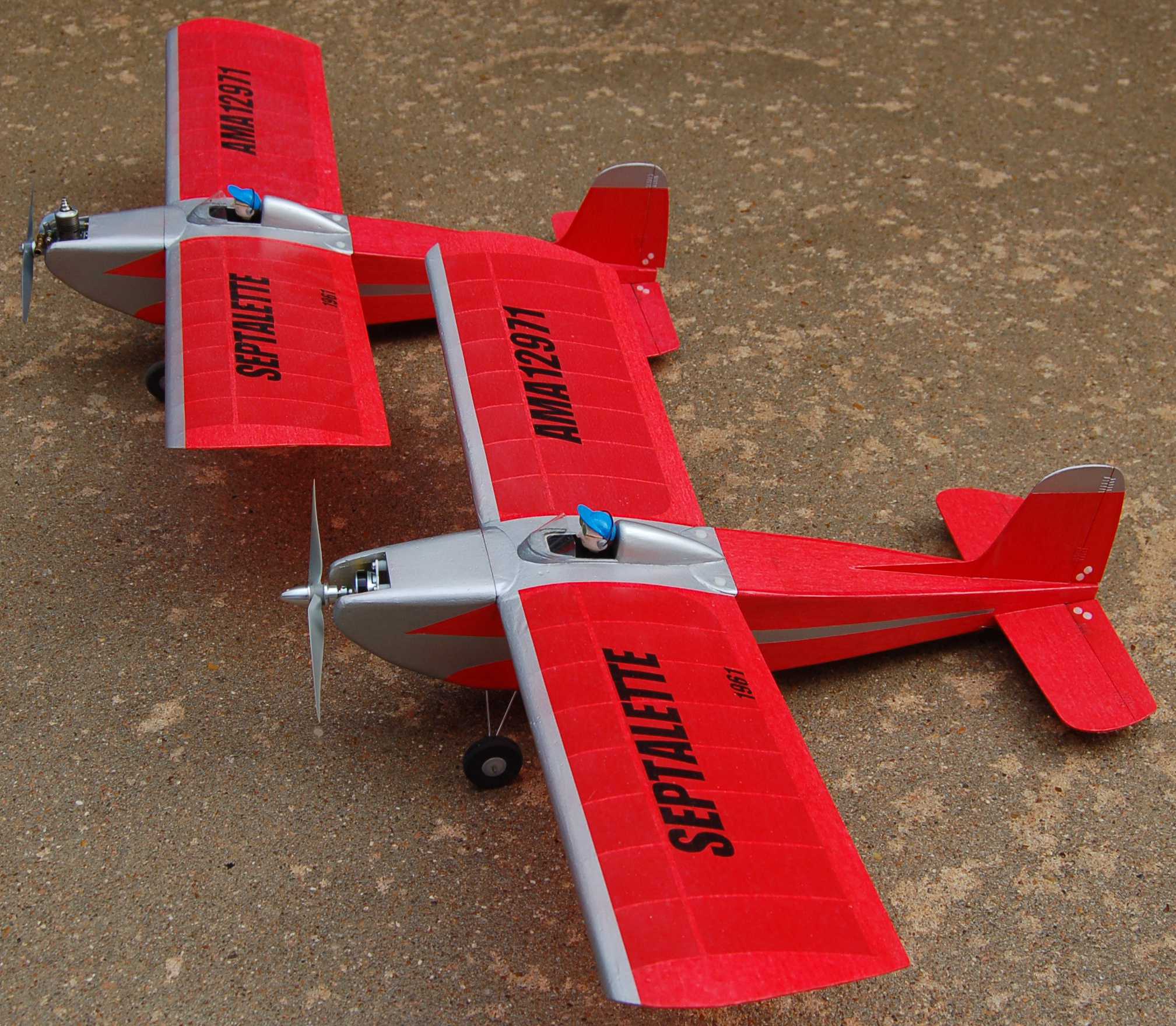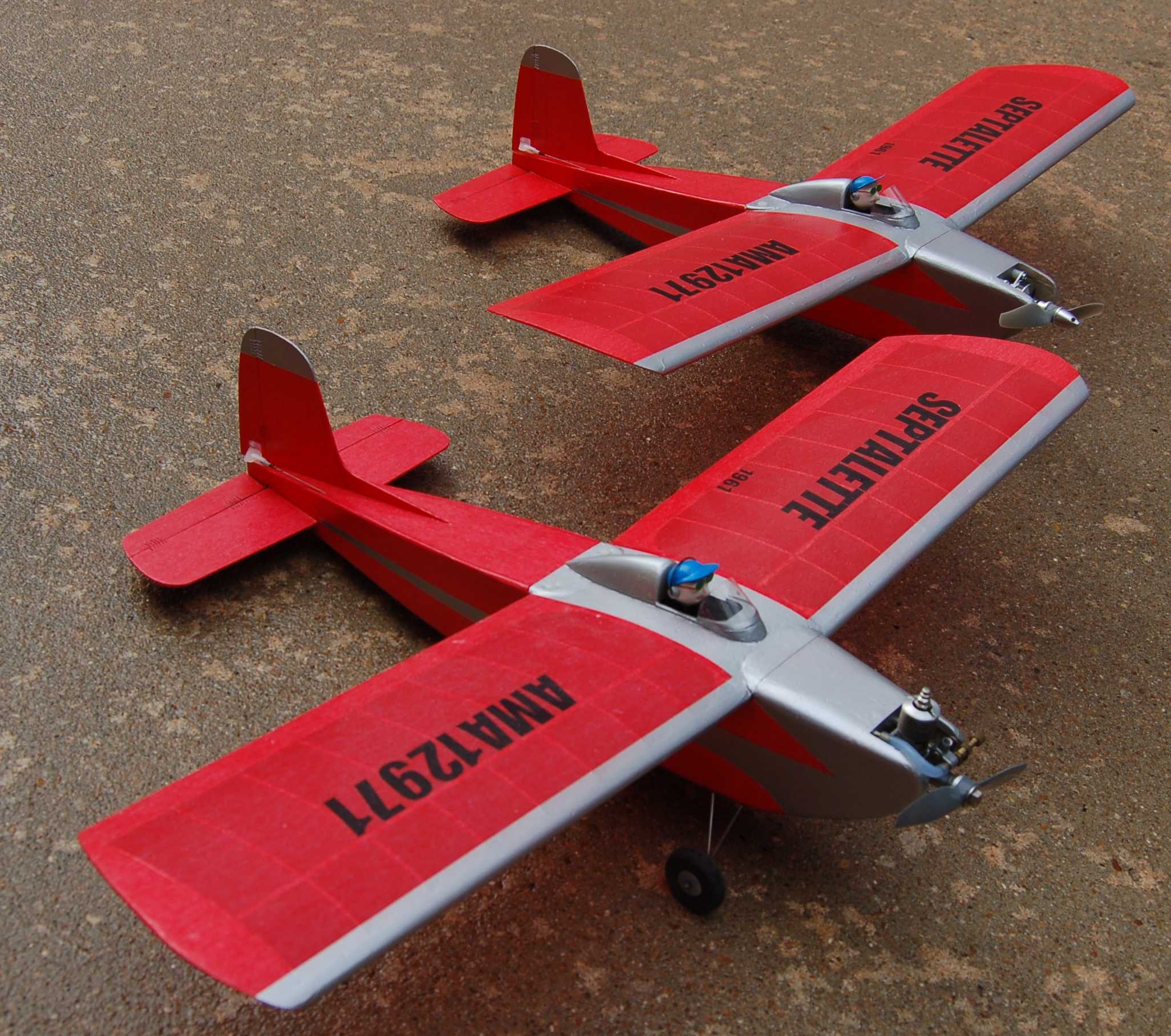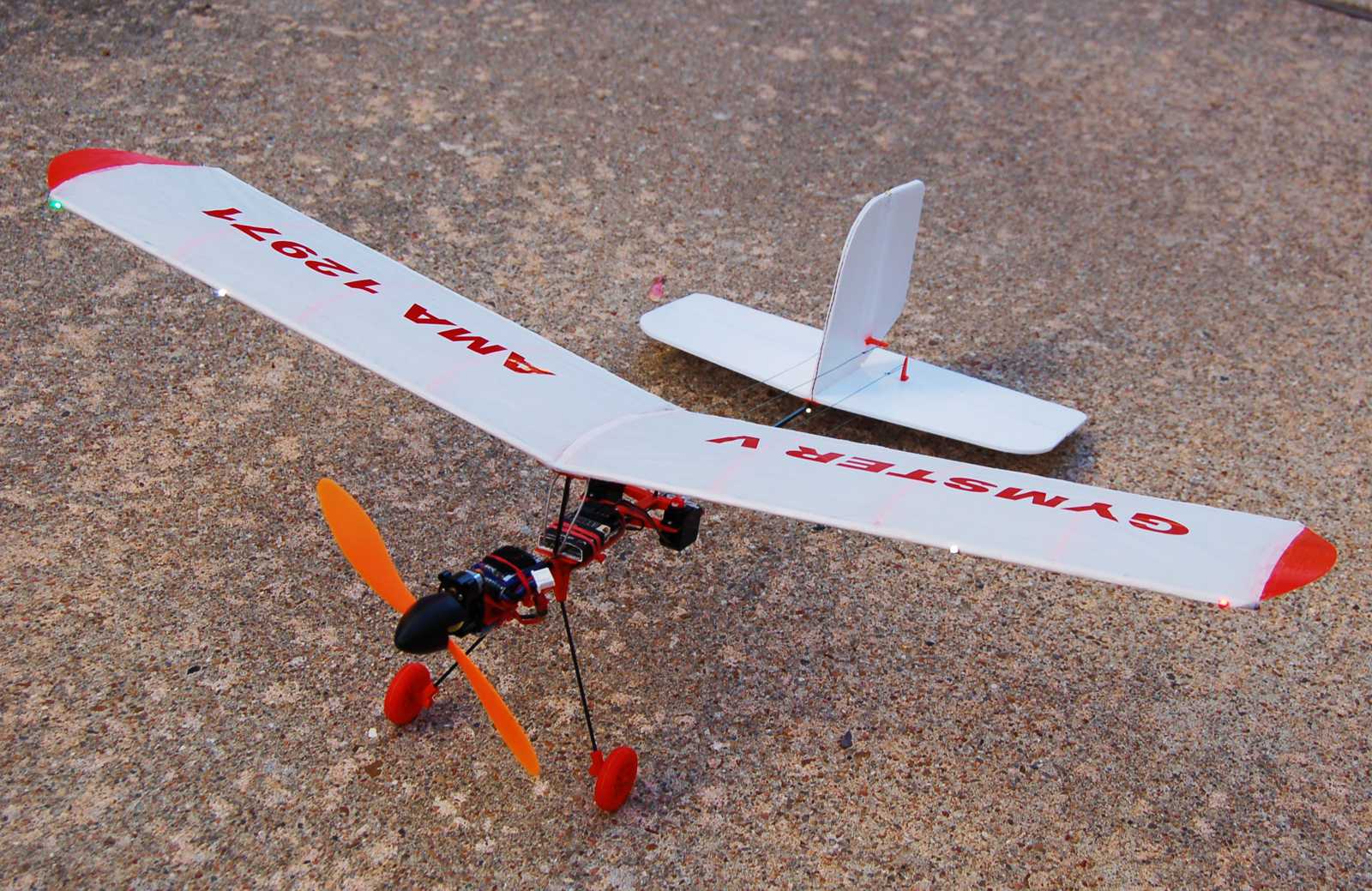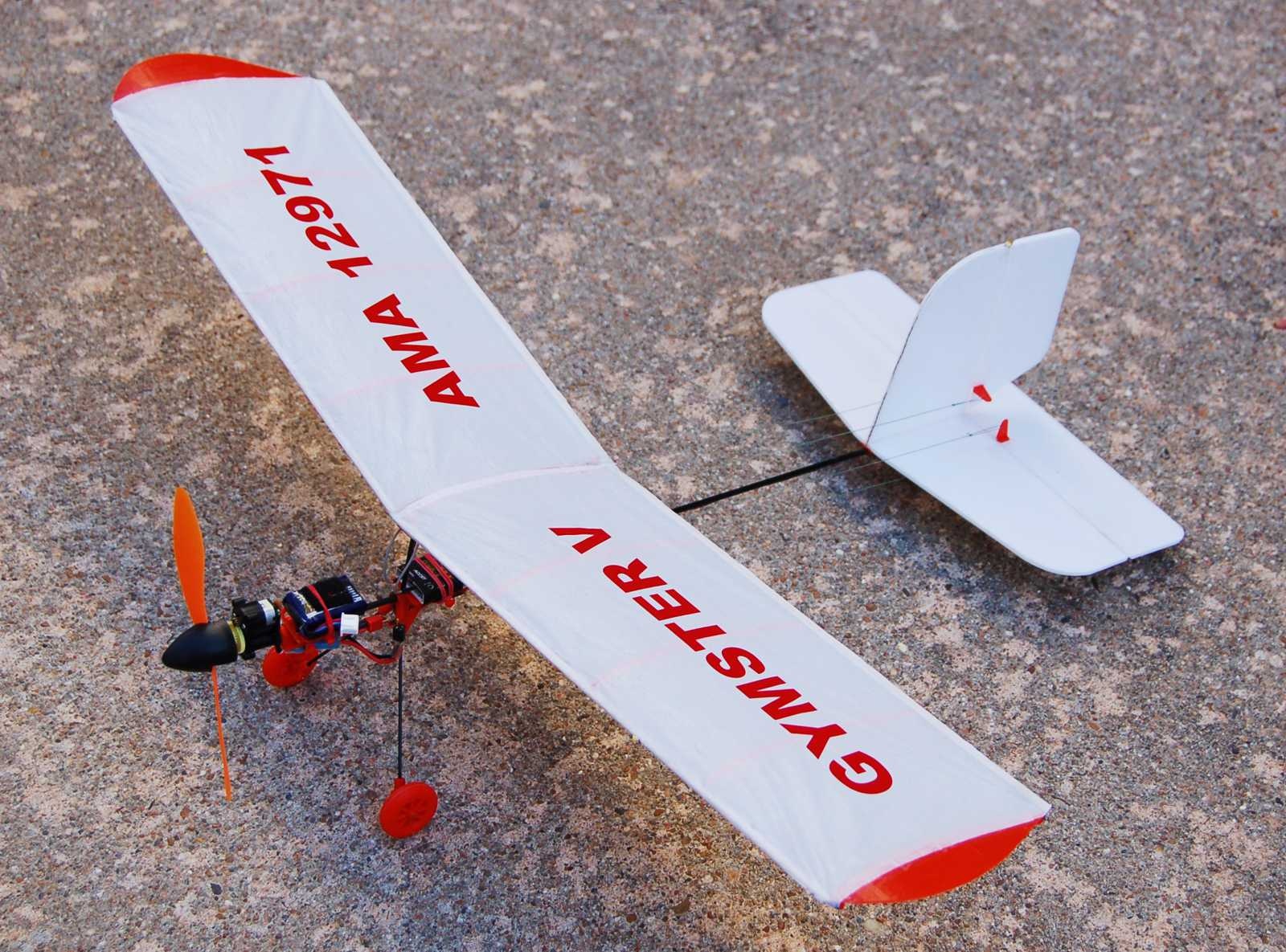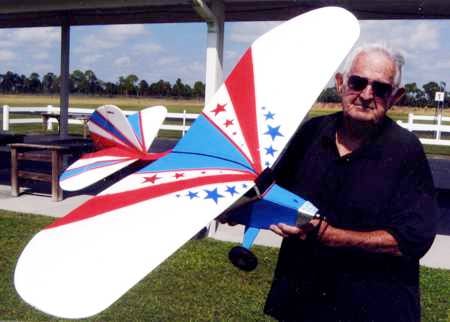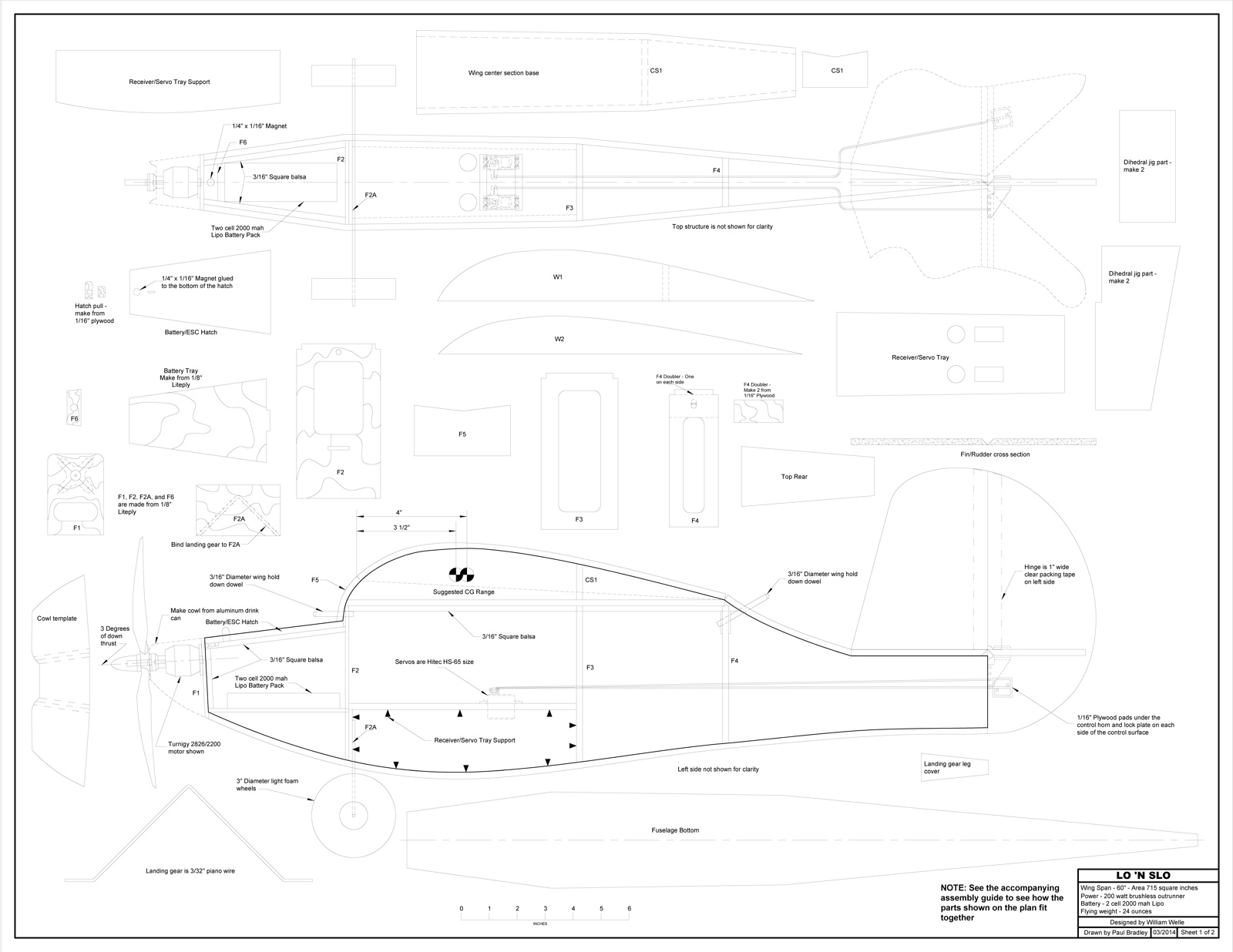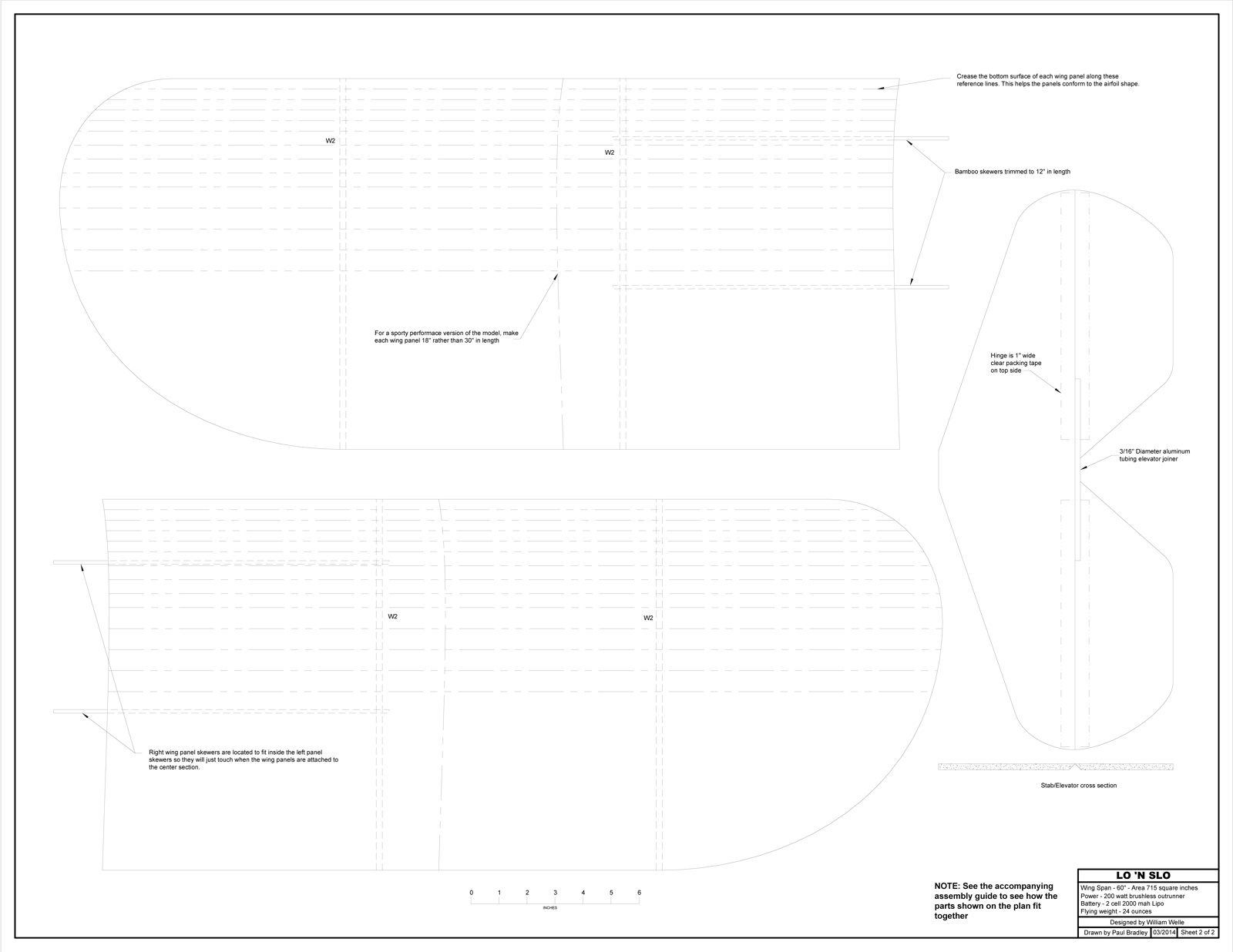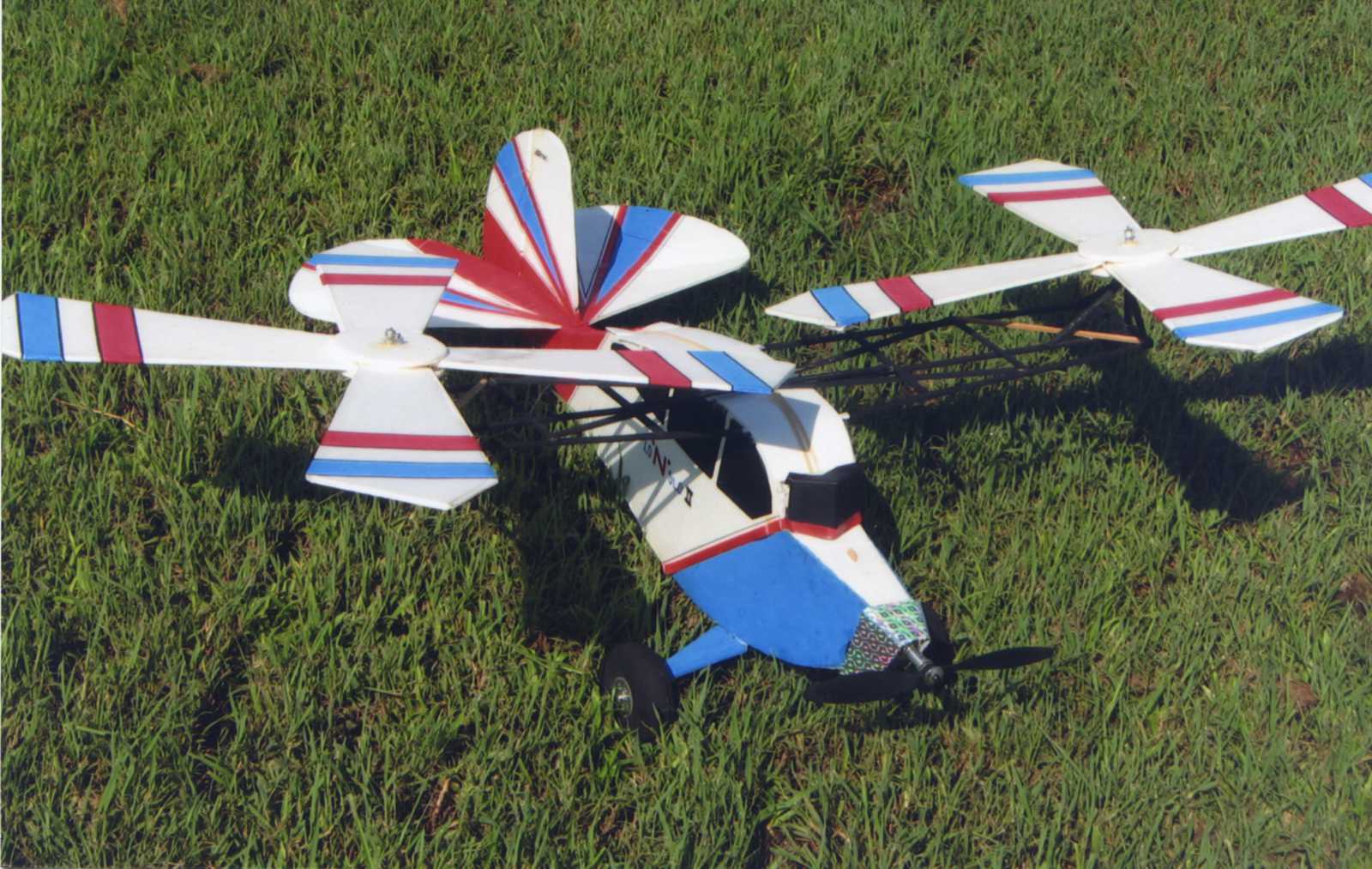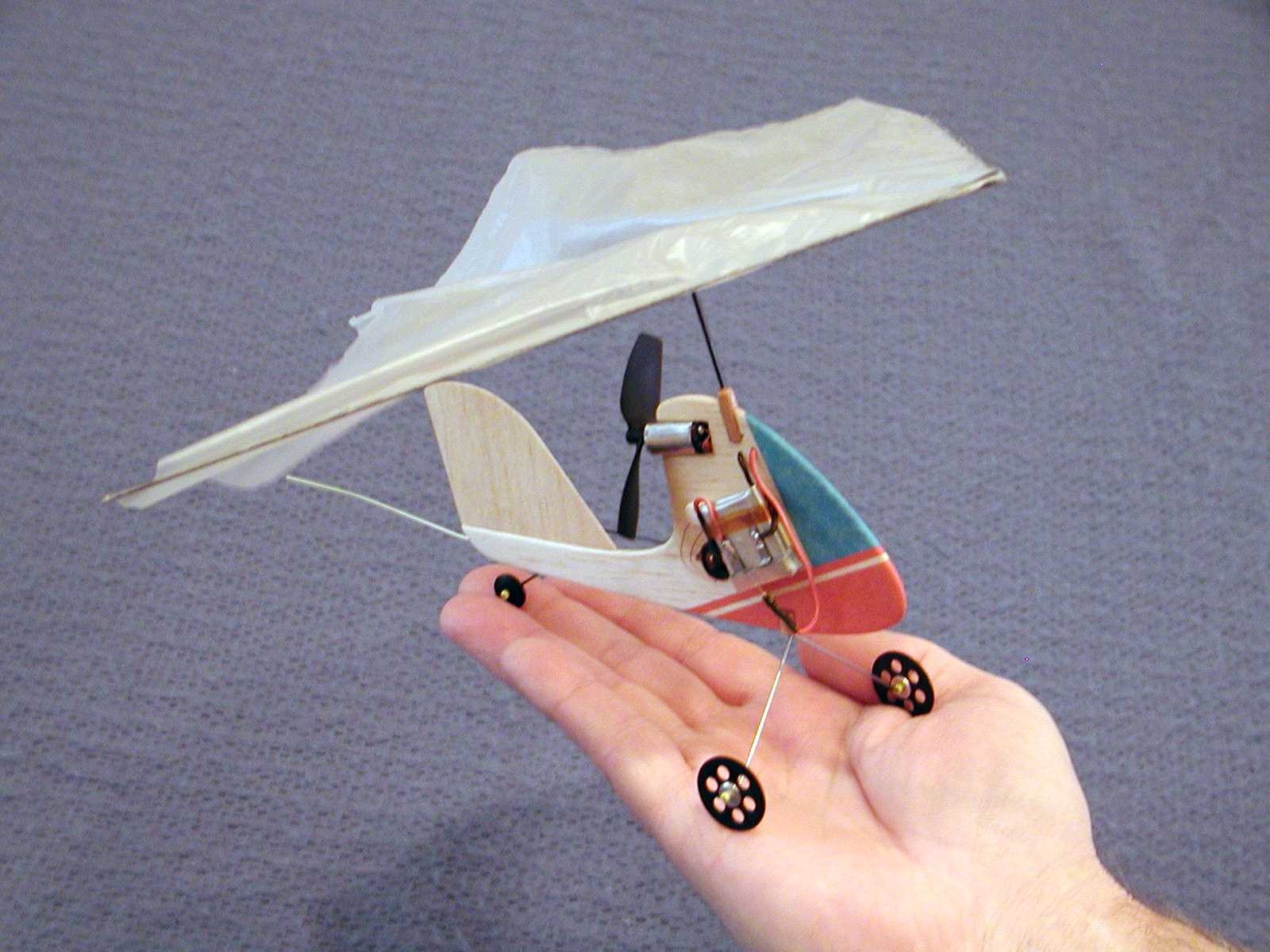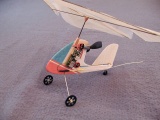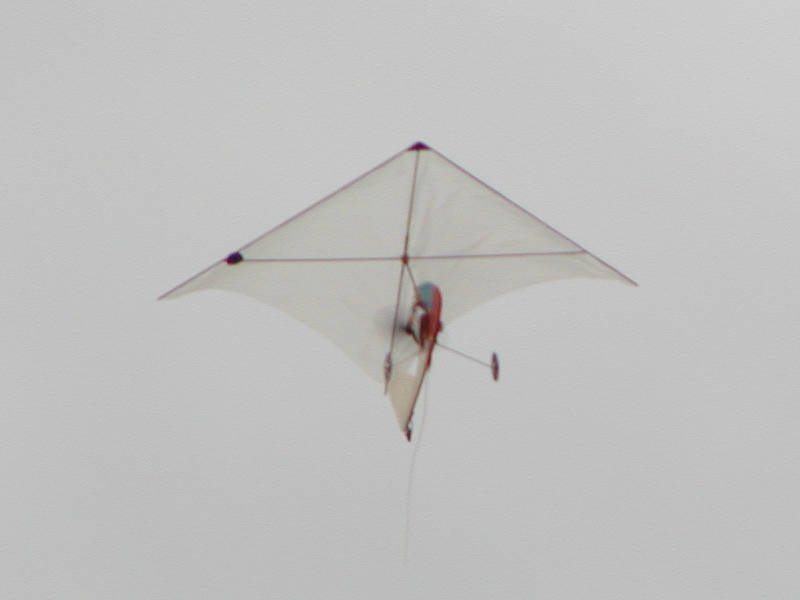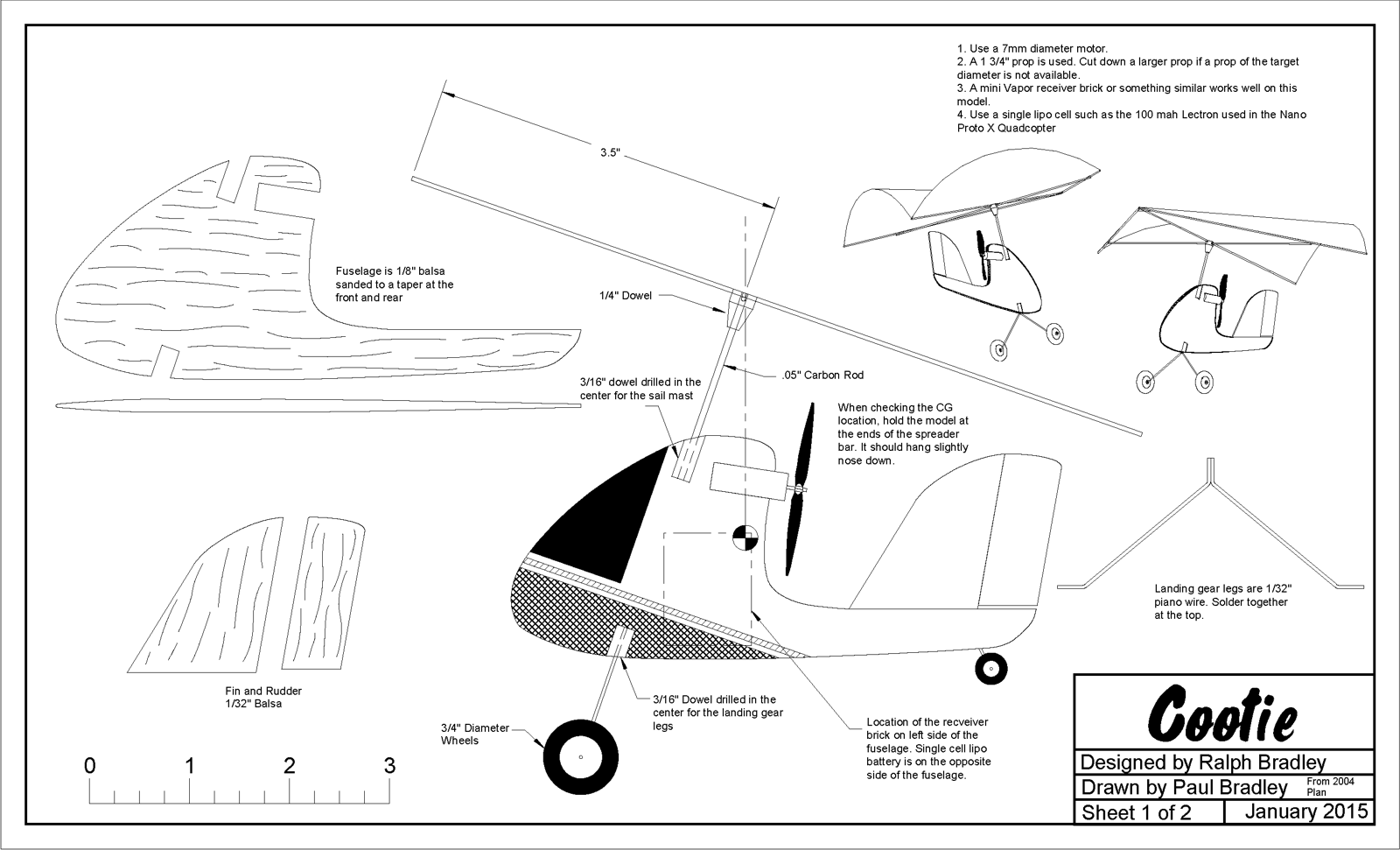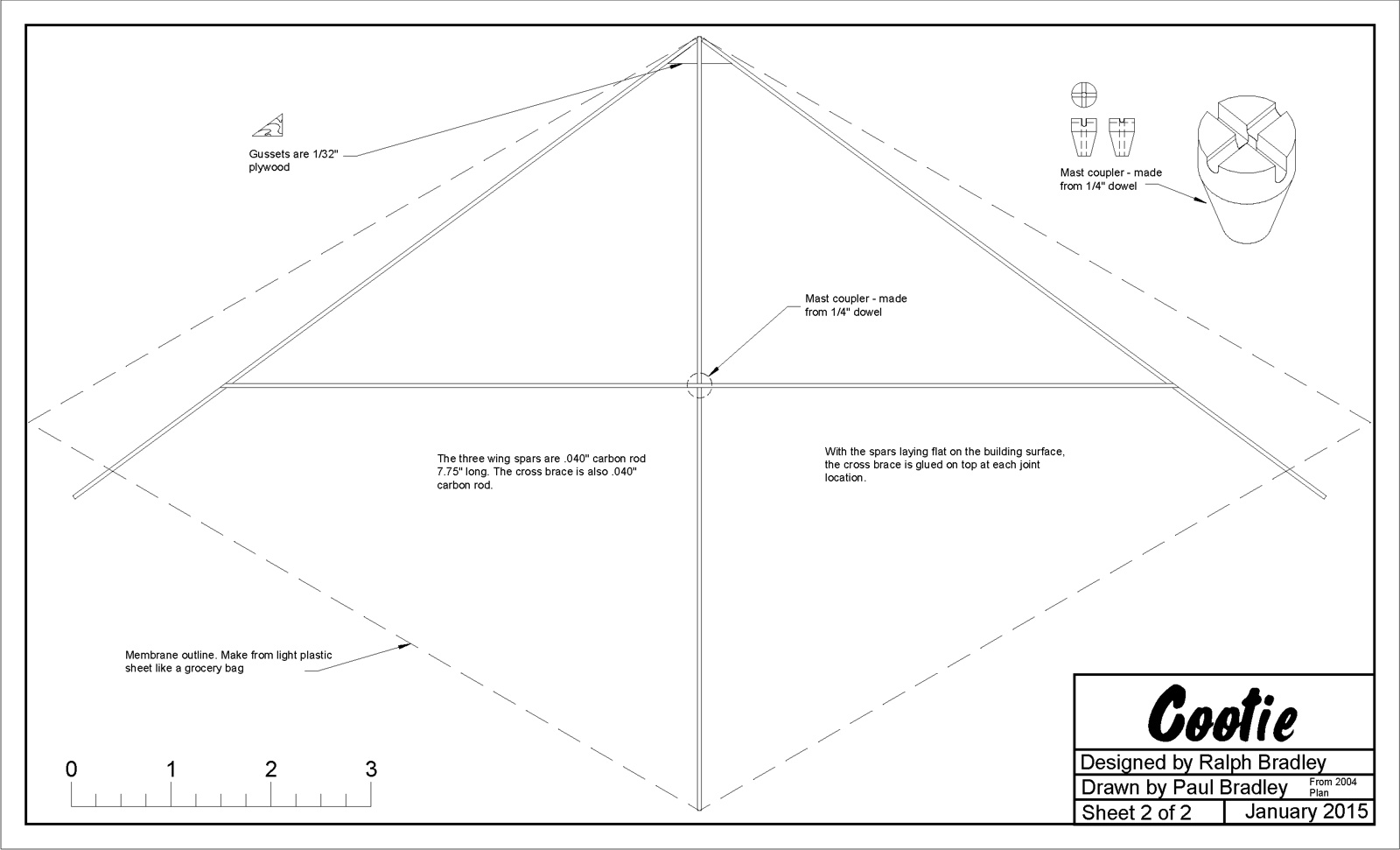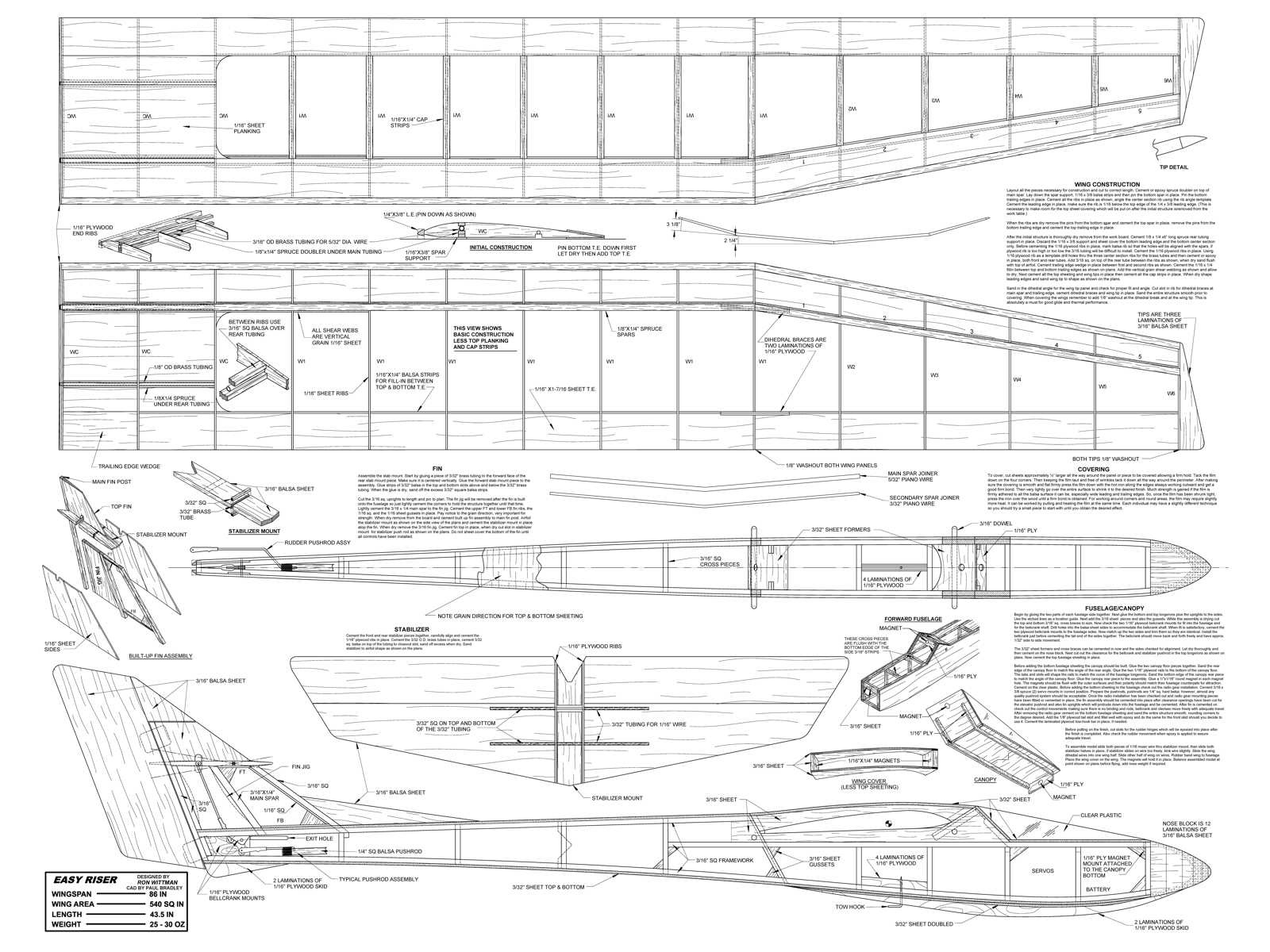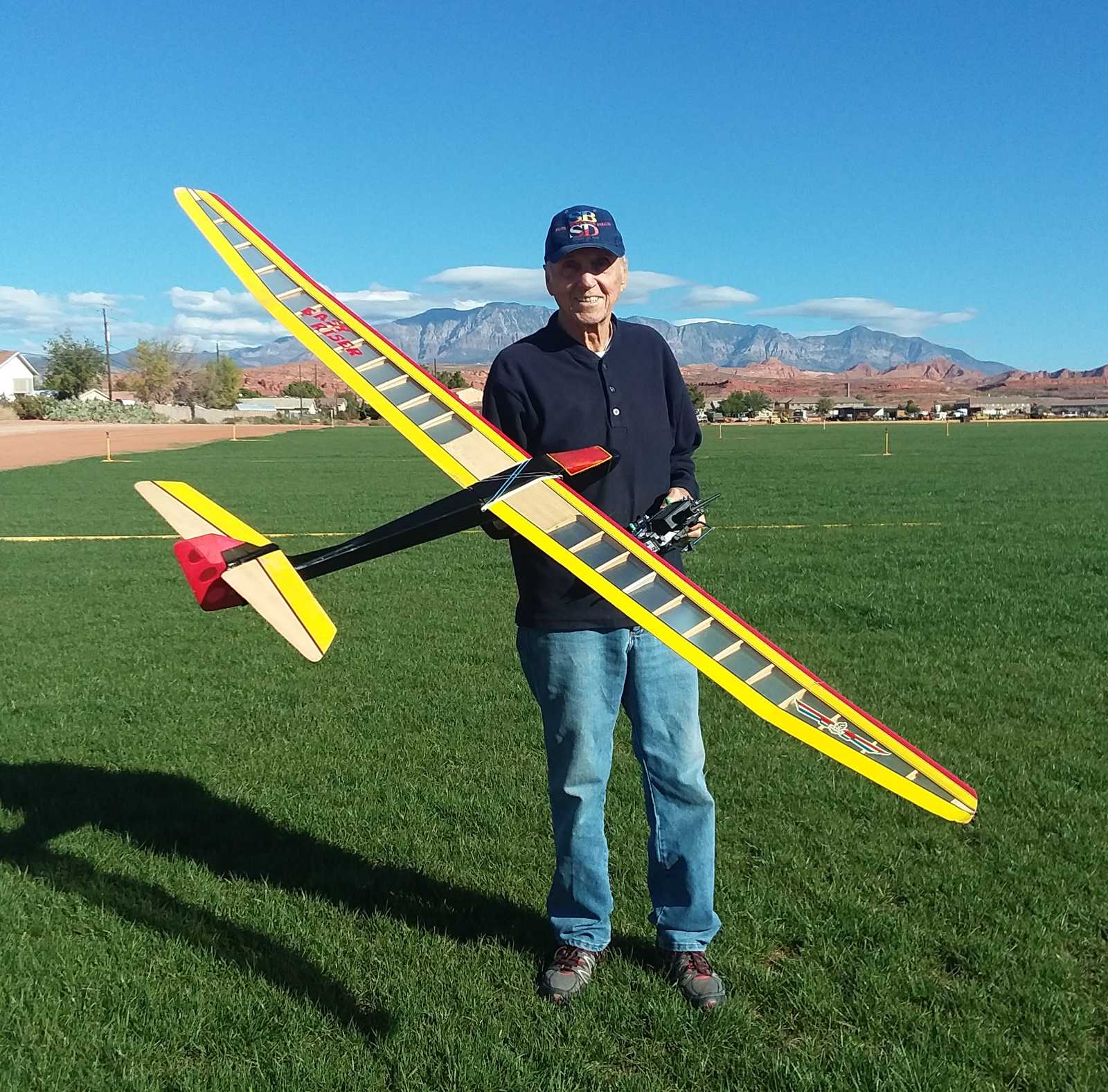Presented here is the Comet 25" Stinson Reliant SR-7 as converted to Radio Control by Paul. The model is essentially the same as the Free Flight version provided in the Comet Stick Model section of the plans pages. It has been modified to provide for a functional elevator and rudder along with the installation of a motor and gear drive from the ParkZone Micro P-51. Energy comes from a single 150 mah lipo cell. Total flying weight is 54 grams as shown in the photos.
One feature of the model that may be a bit unusual is the use of a slide out tray that holds all of the radio control equipment along with the motor/gearbox and battery. The slide out tray is held in place with a pair of rare earth magnets. The radio equipment is a Specktrum AR6400 brick system as used in the ParkZone Micro P-51. That system includes two onboard linear servos and an electronic speed control for the motor. The servos on the AR6400 are connected to the control surfaces using magnets.
Provided here is a modified version of the Free Flight Stinson plan package showing the movable control surfaces and the RC equipment installation. The plan includes all of the parts along with some illustrations showing how the RC gear was installed in the model. The CAD drawn plan package is provided below. The tissue layouts used for creating the printed tissue on this model are also provided below. Also provided is a copy of the original kit plan.
.
You will find a description of the model construction  here. There is a video of the model in flight. It was taken while flying the model outdoors late in the day -
here. There is a video of the model in flight. It was taken while flying the model outdoors late in the day -  video.
video.
The space craft that have been featured in the many different Star Trek television programs and movies have captured the imagination of the many fans of those science fiction stories. Probably the best known of all the space craft used in the Star Trek stories is the Enterprise. For the people who like to build model airplanes the Enterprise models have inspired a number of flying model Enterprise representations.
What is presented here is an electric powered flying representation of the Enterprise. The models of starship Enterprise used to film the television shows and movies of Star Trek went through a variety of configuration changes. The version represented by this plan package is NCC-1701-A as it appeared in the movie "The Voyage Home". The concept for the overall layout of this model was developed by Michael Blott and was first published in December 2001 in the now out of print RC Micro Flight magazine. Michael has given me permission to re-draw his original plan. The original plan from Michael used 3/4" construction foam as the main building material. It also called for a brushed Speed 400 electric motor and a 7 or 8 cell nicad or nimh battery pack. The plan package presented here uses 3 mm sheet foam, a low cost 60+ watt brushless outrunner electric motor, and a three cell Lipo battery pack. The model has also been set up to use ink jet printed tissue graphics as the finish.
To make sure the plan package can be printed on all generally available printers it has been set up to print on 8 1/2 by 14 inch sheets of paper (U.S. Legal Size). The plan package includes an illustrated assembly guide, full size part templates, and graphics for printing on white tissue paper. The model built from this plan package has a 20 inch diameter disk, an overall width of 24", and is 35 inches in overall length. Two different arrangements are presented for the motor installation in the form of a pusher or tractor propeller. The tractor arrangement is lighter while the pusher layout looks better when the model is in flight. Depending on the motor arrangement selected, the completed model will have a flying weight in the range of 14 to 17 ounces. The total flying surface area is 515 square inches. While the model presented here is far from a true scale model of the models used in the Star Trek productions, its shape is unmistakable in flight. It is sure to get plenty of comments at your local flying field.
It is important to note that you should have any print scaling (print to fit printer margins for example) turned off when printing the content of the provided Adobe PDF file.
This model was designed by Ralph when the Astro Flite brushless 010 motor was introduced. At that time the motor represented the small end of the electric brushless motor world. Since that time smaller brushless motors have become available. The Termite still represents a nice flying small field motor glider. The plan presented here can be modified to use any of the small brushless motors and radio equipment currently available.
The plan fits on legal size sheets of paper (8.5" x 14"). The plan has been saved in the Adobe Portable Document Format (PDF). If you do not have the Adobe PDF Reader software, it can be obtained at no cost from the Adobe website at  http://www.adobe.com .
http://www.adobe.com .
It is important to note that you should have any print scaling (print to fit printer margins for example) turned off when printing the content of the provided Adobe PDF file.
Origami E2 by Jack Pignolo. Paper gliders are fun, easy to make, fly well, and are low cost. All of these factors are also desirable for Radio Control model airplanes. Especially those flown in smaller spaces. Jack Pignolo who lives in the greater Houston, Texas area and is also a member of the Downeast soaring club in Maine felt the merits of a paper glider could be adapted to the world of small field radio control model airplanes and developed the Origami E2. The plan package presented here is Jack's design for the Origami E2. The general layout of the model is based on a popular paper glider design. The material used to build the model is sheet foam. The prototype used fan fold foam as sold in home improvement stores for insulation. That foam is about 1/4" thick. 6 mm thick sheet foam that is popular for Radio Control models, such as Depron, is also an excellent material for this model.
A model built from this plan package has a wing span of 38 3/4 inches with an overall length of 28 inches. The total flying surface area is 825 square inches. The total flying weight will depend on the materials used, the selected motor, and battery pack.. The total flying weight should be in the range of 15 ounces.
To make sure the plan package can be printed on all generally available printers it has been set up to print on 8 1/2 by 14 inch sheets of paper (U.S. Legal Size). The plan package includes an illustrated assembly guide, and full size part templates.
It is important to note that you should have any print scaling (print to fit printer margins for example) turned off when printing the content of the provided Adobe PDF file.
Baby Blue X-1 by Jack Pignolo. A popular building material for low cost radio control models is fanfold foam. This material is used in the construction of buildings and homes and is sold at most home improvement stores. It is relatively low cost and produces models that are durable and easy to repair. Jack Pignolo demonstrated what can be done with a little imagination and a stack of fanfold foam with his Origami E2 model. That model uses a flat plate wing like the paper airplane that inspired the design. Fanfold foam is not limited to flat plate wing models. With the Baby Blue X-1 Jack takes the next step to a full airfoil wing. The resulting model is still quite easy to build, light weight, and durable.
The plan package presented here contains an illustrated assembly guide and part templates that become full size after they are assembled. A model built from this plan package has a wing span of 30.5 inches with an overall length of 20 inches. The total flying surface area is 382 square inches. The total flying weight will depend on the materials used, the selected motor, and battery pack.. The total flying weight should be in the range of 11 ounces.
To make sure the plan package can be printed on all generally available printers it has been set up to print on 8 1/2 by 14 inch sheets of paper (U.S. Legal Size). The plan package includes an illustrated assembly guide, and full size part templates.
It is important to note that you should have any print scaling (print to fit printer margins for example) turned off when printing the content of the provided Adobe PDF file.
Combat Foamie by Jerry Hagood. Jerry Hagood and his friends are having fun flying full contact combat matches with foam based electric powered RC model airplanes. The size of their models is ideal for smaller flying venues. The key to their models is light weight, inexpensive components, quick build time, easy repair, and most important a high fun factor. Presented here is the combat foamie design developed by Jerry over a period of several years. This is a great design for organizing full contact combat matches with your friends and club mates.
A model built from this plan package has a wing span of just under 23 inches with an overall length of 20.6 inches. The total flying surface area is 345 square inches. The total flying weight will depend on the materials used, the selected motor, and battery pack.. The total flying weight should not exceed 8 1/2 ounces.
To make sure the plan package can be printed on all generally available printers it has been set up to print on 8 1/2 by 14 inch sheets of paper (U.S. Legal Size). The plan package includes an illustrated assembly guide, and full size part templates.
It is important to note that you should have any print scaling (print to fit printer margins for example) turned off when printing the content of the provided Adobe PDF file.
Double Trouble by Jerry Hagood.The Combat Foamie designed by Jerry Hagood has proven to be a lot of fun. Jerry and his club mates have been enjoying the exhilarating world of full contact combat flying with models like the Combat Foamie. As you might suspect, combat fliers are always looking for ways to get an edge on their opponent. Jerry is no exception and has taken the Combat Foamie to a new level by adding a second motor. The resulting model is known as Double Trouble. Like the Combat Foamie, Double Trouble is constructed from fanfold foam. The relatively inexpensive material, sold at home improvement stores, allows for quick building model airplanes that are durable and easy to repair. The latter feature is especially good when it comes to full contact combat models. If you are looking for a bit of an adrenalin rush with a smaller model, take a look at Jerry's Double Trouble.
A model built from this plan package has a wing span of 27 3/4 inches with an overall length of 20 1/2 inches. The total flying surface area is 418square inches. The total flying weight will depend on the materials used, the selected motor, and battery pack.. The total flying weight should be in the range of 13 ounces. The plan package includes an illustrated assembly guide and full size part templates are created by assembling keyed printed pages.
To make sure the plan package can be printed on all generally available printers it has been set up to print on 8 1/2 by 14 inch sheets of paper (U.S. Legal Size). The plan package includes an illustrated assembly guide, and full size part templates.
It is important to note that you should have any print scaling (print to fit printer margins for example) turned off when printing the content of the provided Adobe PDF file.
Mini-E-Bipe a design by Carl Hock. Back in a earlier time period for model aviation Lou Roberts published a nice 1/2A control line profile biplane plan in Flying Models Magazine. When Carl happened across that article he immediately saw the potential for a current day radio control model. Scaled up a bit from the original plan and substituting foam for sheet balsa he derived the Mini-E-Bipe. It has a wing span of 20 inches and a flying weight of 4.7 ounces. It is a great model for smaller flying sites and depending on the venue can be flown indoors.
Present here is the plan package as drawn by the designer Carl Hock. Two versions of the Mini-E-Bipe are provided. One is a lighter weight model that is suitable for indoor flying and the other is just slightly heavier for outdoor flying. In keeping with the heritage of the design, and as a bonus he has also included a control line version of the Mini-E-Bipe. All together there are three plan and corresponding part template packages.
To make sure the plan package can be printed on all generally available printers it has been set up to print on 8 1/2 by 14 inch sheets of paper (U.S. Legal Size). The plan packages are set up to create a full size plan from legal size sheets that are taped together. The part packages are set up to allow fill size part templates to be created from keyed printed pages.
It is important to note that you should have any print scaling (print to fit printer margins for example) turned off when printing the content of the provided Adobe PDF file.
CAD Drawings by Carl Hock. In 1961 Grid Leaks published a 1/2A single channel radio control model design called the Septallete. This model has a lot of character and was also a good flying model airplane in its day. Carl Hock has gone back in time to pull this very nice design into the current day. Not only has he taken the time to redraw the original glow powered model using CAD, he has also provided a version of the model design for electric power. He built examples of both models from his CAD drawn plans. We can tell you after watching them at SMALL 2012 they fly really well.
To make sure the plan and parts packages can be printed on all generally available printers they has been set up to print on 8 1/2 by 14 inch sheets of paper (U.S. Legal Size). The full size plan is created by taping together the individual printed sheets. The part packages also include photos of Carl's models under construction to aid anyone building models from his plan packages.
It is important to note that you should have any print scaling (print to fit printer margins for example) turned off when printing the content of the provided Adobe PDF file.
Gymster by Carl Hock. Carl Hock from the greater Houston, Texas area has been developing a nice indoor/outdoor design called the Gymster. The design has been evolving over a several year period. During this period Carl has been exploring the world of 3D printing. The Gymster V presented here is a compilation of the things he has learned about the design and his growing experience with developing 3D printed model airplane parts.
To make sure the plan and parts packages can be printed on all generally available printers they has been set up to print on 8 1/2 by 14 inch sheets of paper (U.S. Legal Size). Along with the Adobe PDF file that contains the plan and building notes, a zip file is also provided that contains the 3D models for the parts that are 3D printed. The 3D print files are in the stereo lithography (STL) file format.
It is important to note that you should have any print scaling (print to fit printer margins for example) turned off when printing the content of the provided Adobe PDF file.
Lo 'N Slo by Bill Welle. If you are looking for a slow flying model in a size that is easy to handle and see in the air, this may be your next project. Designed by Bill Welle, the Lo 'N Slo uses foam board as the main building material. This is a great material for model airplanes. It is relatively low in cost, light weight, easy to work with, and has a nice smooth paper surface that is easy to decorate. It can be purchased where office supplies are sold as well as many discount stores. Typical sheet size is 30" x 20". The very best foam board for model airplanes is Readi-Board by RL Adams Plastics. It is sold by Dollar Tree. This is the best foam board for use with the Lo 'N Slo as it is lighter than other foam board brands. If you do not have a Dollar Tree in your area, Readi-Board can be purchased on line from the Dollar Tree web site at  dollartree.com.
dollartree.com.
Specifications for the model are as follows:
Wing Span - 60" (36" Span Sporty Option)
Wing Area - 715 square inches
Flying Weight - 25 ounces
Power - 200 watt electric outrunner motor
Battery - Two cell 2000 mah Lipo
Presented here is the two sheet full size plan, full size part templates (multiple printed sheets taped together where needed), and an illustrated assembly manual. All of the downloadable documents are in the Adobe PDF file format. The full size plan can be taken to a print shop to be printed full size, or it can be printed at reduced scale using the Adobe print scaling features. It can also be tile printed by the Adobe software and then taped together. The part template package should not use any print scaling. When printing the part template package be sure Actual Size is selected for print scaling. The part template package has been set up to print on 8 1/2 by 14 inch sheets of paper (U.S. Legal Size). The assembly manual is set up to print on U.S. letter size sheets (8.5" x 11").
Designed by Bill Welle, the Lo 'N Slo is a great small field slow flying RC model that uses foam board as the main building material. Bill has developed an autogyro conversion package for the model. It simply replaces the wing. Chaging the configuration from a fixed wing model to an autogyro is simply a matter of removing the hold down rubber bands, removing the current lifting surface, and then rubber banding down the flying surface you want to use for a given flight. Much of the autogyro conversion uses the same foam board as the basic Low 'N Slow. This is a great material for model airplanes. It is relatively low in cost, light weight, easy to work with, and has a nice smooth paper surface that is easy to decorate. It can be purchased where office supplies are sold as well as many discount stores. Typical sheet size is 30" x 20". The very best foam board for model airplanes is Readi-Board by RL Adams Plastics. It is sold by Dollar Tree. This is the very best foam board for use with the Lo 'N Slo as it is lighter than other foam board brands. If you do not have a Dollar Tree in your area, Readi-Board can be purchased on line from the Dollar Tree web site at  dollartree.com.
dollartree.com.
Presented here are the full size part templates (multiple printed sheets taped together where needed), and an illustrated assembly guide. All of the downloadable documents are in the Adobe PDF file format. The part template package should not use any print scaling. When printing the part template package be sure Actual Size is selected for print scaling. The part template package has been set up to print on 8 1/2 by 14 inch sheets of paper (U.S. Legal Size). The assembly manual is set up to print on U.S. letter size sheets (8.5" x 11").
The Cootie by Ralph. Micro RC models can be a lot of fun. Especially when flown indoors. Ralph as developed a number of indoor micro RC models over the years. Back in the early 60's when the Rogallo Wing was in the public eye due to development efforts by NASA, we both developed an interest in the concept. We built several models that used the Rogallo Wing and had great fun. Rolling the clock forward to the present day, Ralph wondered if the Rogallo Wing would work well for an indoor micro RC model. The result is the Cootie.
The Cootie works well with RC bricks like those available from Horizon Hobby. It has proven to be a great indoor flier. It is easy to build and can deliver a lot of indoor flying fun. The plan is two sheets in the Adobe PDF file format. The sheets are US letter size (81/2" x 11"). When printing the two sheets make sure print scaling is set to Actual size.
The Easy Riser designed by AMA Hall of Fame member Ron Whittman became a design trend setter when it appeared in the 1960's. Presented here is a CAD redrawn plan based on the original Competition Models kit plan, and layouts suitable for laser cutting of the parts.
Two laser cut file layouts are provided. One for 36" long sheets, and one for 24" long sheets. Most laser cutting service providers can handle those balsa sheet lengths. The layouts for 24" sheets have the fuselage sides made up of two parts. The 36" length layouts have the fuselage sides as one piece. The colors used on the cut files are black for cut lines, blue for defining the sheets, and green for etching. The cut files are in the Autodesk Drawing eXchange Format (DXF).
A good laser cutting service is  Manzano Laser Works. The laser cut files use line colors that are compatible with the standards used by Manzano Laser Works.
Manzano Laser Works. The laser cut files use line colors that are compatible with the standards used by Manzano Laser Works.
This is a FaceBook Group developed by Doug Morris. It allows people world wide to share their models and is also a repository for plans. Many of the plans are foam based and represent low cost options for building some nice flying Radio Controlled model aircraft. To gain access to the downloadable files section, you do need to become a member of the group. To do that you need to answer three questions. The questions are designed to make sure that modelers are requesting admission to the group as opposed to people with other intents.
Here is the FaceBook Group link:  https://www.facebook.com/groups/LowBudgetRCPlanes/
https://www.facebook.com/groups/LowBudgetRCPlanes/
Copyright 2025 Paul and Ralph Bradley's Model Airplane Hangout
